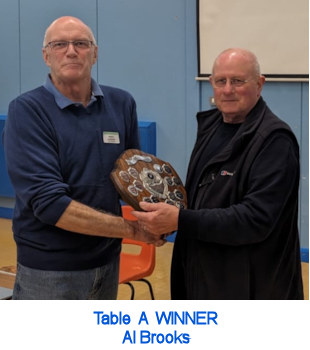
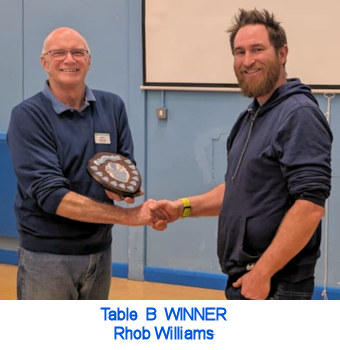
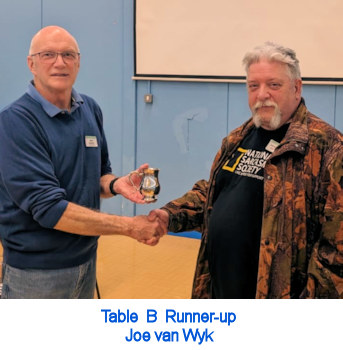
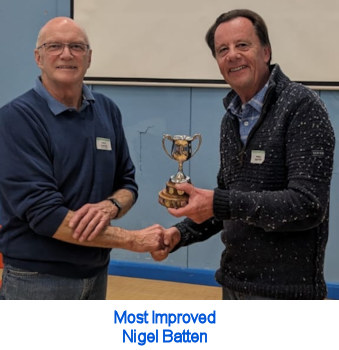
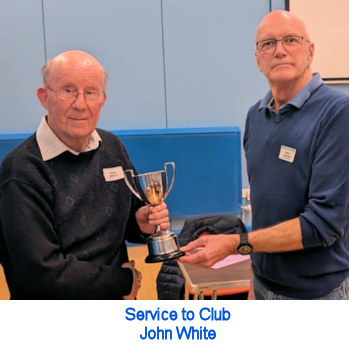
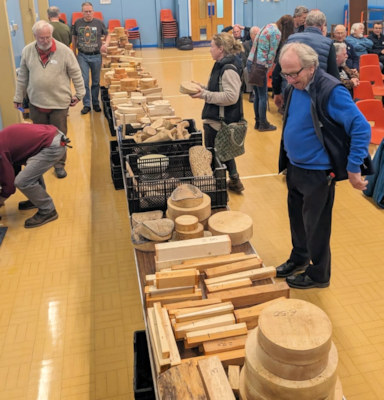
The meeting finished with its usual wood sale
Members Work
for
Club Years 2023 & 2025
April 2023 to March 2025
Attended by 42 Members who heard the
Chairman talk of a flourishing Club with many new Members demonstrating very
good skill levels. Secretary, Trevor Elliott stood down from the Committee and
Jane Wild was duly elected as the new Secretary. Joe van Wyk was also elected to
the Committee.
The Club has negotiated a discount with Yandles for wood sales and with
Axminster Tools for 'own brand' products when ordered through the Treasurer.
The following trophies were presented by the Chairman.
Table A winner - Alan Brooks
Table A runner up - Andy Ogilvie
Table B winner - Rhob Williams Table B runner up - Joe van Wyk
Best Beginner - Rhob Williams Most Improved - Nigel Batten
Creativity/Innovation - David Patrick
Presidents Design - Alan Brooks Service to the Club - John
White
plus a Special Presentation to Paul Reeves of a copy of Jonny Marrs Guitars by way of acknowledgement for all his demonstrations and technical help.






The
meeting finished with its usual wood sale
February 2024 -
Comp
5
Racing Cars
TABLE A
(click any below for close up view)
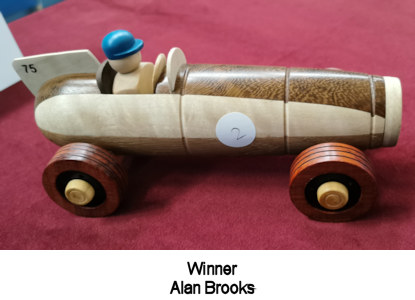

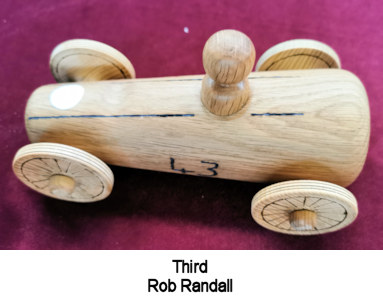
(click any above for close up view)
TABLE B
(click any below for close up view)
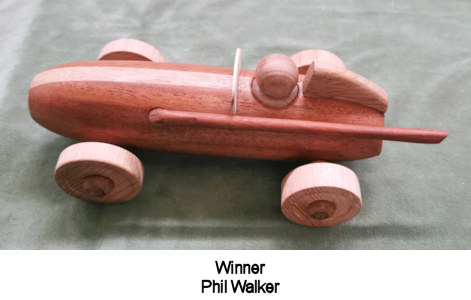
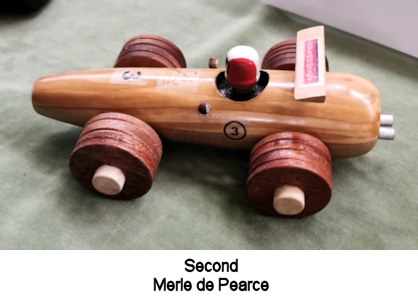
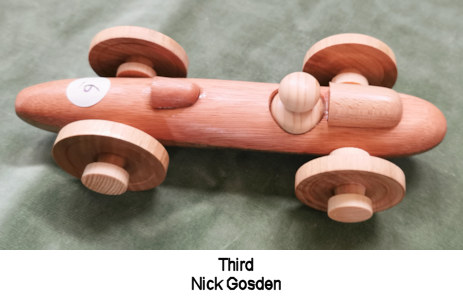
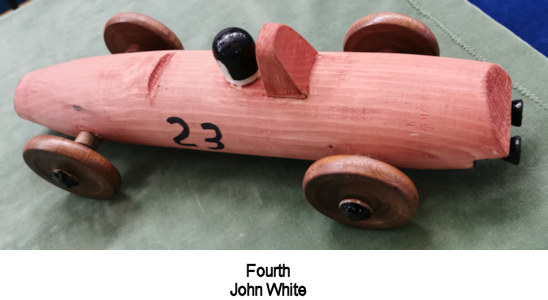

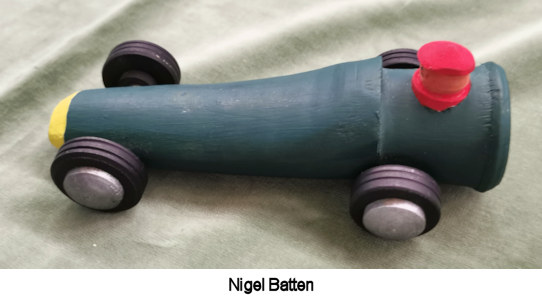

(click any above for close up view)
Subsequent to the judging, a Trials
Race took place on the slippery floor of the Community Centre.
Each driver was allowed 3 attempts with the furthest from the start being the
one that counted. (One car had to be retired and taken back to the
Paddock with axle failure).
The winner was John White who was awarded the Les Thorne Trophy (The piece
that Les turned for his April 2023 demonstration).
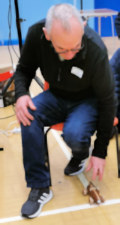
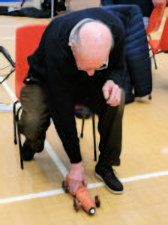
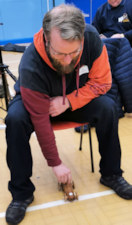
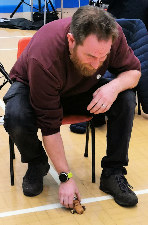
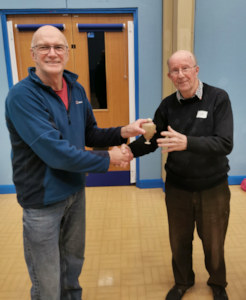
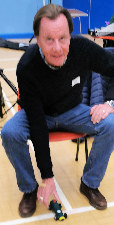
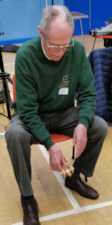
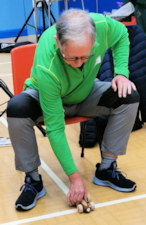
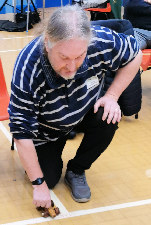
February 2024 -
Appraisal Table
with Andy Ogilvie
David Patrick's tall vase (about 24") looks
very impressive but when one stops to consider what he had to do in preparation,
one can only admire his workmanship even more because of what was required to
produce this piece. The chevron part alone seemingly required 28 pieces of
precisely cut blocks that adjoined each neighbour so crisply that there were no
holes showing at every glued joint. The piece was so long that David chose to
design & build a Lathe Steady to fit his rails before he would finish the piece.
With so many joints to glue, it was remarkable that every joint looked good.
This was truly a commitment of great care and attention to detail and an
excellent job done.
Nigel appears to have been seriously developing a racing car for the
competition but in fact these two were turned 3 years before for grandchildren,
who had clearly been playing with them a lot because they had been returned to
the manufacturer for repairs! Apparently, these two also benefited with
'upgrade' furnishments from points discovered from his competition piece.
John's 'Ladies' is a useful way to showcase different woods in small
pieces, which work particularly well when displayed together. A case of a
set achieving more than the sum of the individual pieces.
John commented that this project convinced him that felt tipped decoration was
just as good as painted but much quicker.
Andy's Laburnum box was finished with a Boxwood lid decorated like many
have done for teapot stands; that is by using a Parting Tool to create the same
depth grooves on one face before holding the piece to create grooves on the
obverse face, but this time using an offset centre. Andy said he wasn't
happy with his first attempt which showed disappointing cracks appearing where
the underneath grooves intersected the upper grooves. This problem seemed
to be resolved when the underneath grooves' depth coincided exactly with the
bottom of the upper grooves' depths.
Rhob produced several items for appraisal, all of which had little hidden
finishes to admire. His goblet with a captive ring had a beautiful
spiralling feature underneath the base. The thickness of the rim was just
perfect in proportion to the piece and a 'crackle glaze' had been applied to
this and to a platter he had brought as well. Another platter was decorated with
spirit stains in autumnal features & colours plus another spiralling finish to
where the spigot had been. Following previous months of Sauracker Shell pieces,
Andy was delighted to see an adapted example with flattened arc shapes and
scalloped edge shaping which clearly distinguishes it from some sort of place
mat. Then there were 2 pieces in one using Judas wood and
an Acacia hollow form with some dazzling decoration.
January 2024 -
Appraisal Table
with Paul Reeves
Paul started with comments about
Kururin, which is a wooden tumbling peg derived from a Nintendo video game.
These pegs are shaped such that when they are skilfully toppled over, the
movement allows the peg to spin back onto its end and if started off with enough
force, they can topple over and up again several times. Their production
makes for a good exercise in precise and repetitive long curve turning. Density
of wood has a significant influence over the number of consecutive topples. In
the photo, the left two are of Sycamore (weighing 25g), then Kingwood (50g) and
far right is of Indian Ebony (53g).
David had produced a grand segmented bowl. Paul admired his patience for gluing
segments together for each gradually larger ring and then assembling each ring
with more glue before starting to turn the bowl. Joints tended to be the problem
and it was important to use the right glue to avoid holes appearing between the
segments due to expansion or lack of glue.
Andy has been experimenting with
some Sauracker Shells. Paul had seen them previously and remarked that they
would make marvellous lids for boxes. Not one for ignoring a challenge, Andy went
further by producing a box within a box.
Ian's box started off with a golden yellow colour similar to Robinia but with
age, the colour has changed to a shade of bronze, which indicates it must be of
Mulberry.
Joe's peppermill is of an Ash body with spalted Box top.
Alan has been turning another wooden incense Smoker Figurine. Paul highlighted
just how many turned components have to be produced before the finished piece
can be assembled. Following on from last month's light bulb project, Alan had
combined his attempt with a candlestick. Paul particularly admired the stick's greater
difference between wide and thin diameters as being more appealing than a
Victorian style.
From a distance, Phil's candlestick
Tea Lights could have been mistaken for Banksia Nut but were another example of
segmented turning. Paul considered the two of them were excellent pieces and his
only helpful point to add was that such fine work was let down by the tailstock
point still visible in the bases. However, the pieces were still capable of
being re-mounted and such evidence removed.
Nick is relatively new to woodturning and his bowl had been finished extremely
well. Novice turners are renown for not sanding out tool marks and for leaving
sanding circles in the surface. This was a bowl that the turner had taken
considerable care to finish without any of those 'newbie errors'. The plate had
been turned from Oak furniture wood from a quarter-sawn plank showing off the
Medullary Rays within the wood and the holes were from a screwed feature of the
original, which adds interest to the piece. Finally, Nick's Walnut box had
a comforting pop to removing its lid. It was a pleasing shape but to Paul's
taste, a little on the heavy side for its size - the wall thickness in his
preference should have been half the size Nick had chosen but he accepted that
Nick had wanted it to be like that; and why not?
John's wood shavings cast in resin was something new to those present. He had
done the piece several years before and thought he had mixed the shavings with
the resin before pouring into a mould although the shavings appeared very evenly
spaced.
Paul joked that Rhob had obviously been working hard over December because he
had only brought in 5 items this month. The pens were meticulously
finished and his small walnut hollow form had additional features like decorated
rim and filled cracks. Paul has always advocated to start turning small hollow
forms to learn from one's mistakes before tackling larger pieces and ruining a
piece after hours of work and having to start again.
December 2023 -
Appraisal Table
with Andy Ogilvie & Paul Reeves
This month's theme was items Members had turned which were 'out of the ordinary'.
(click any below for close up view)
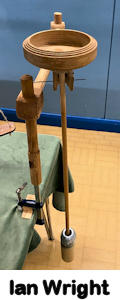
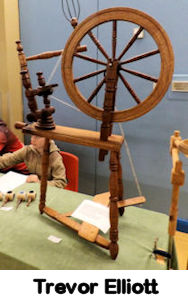

Ian's unusual piece is one
project, later adapted to a second project. The articulated part was designed
for a bed-bound patient to have a level tray for drinks readily available to be
safely swung close inwards while anchored to the edge of the bed. The adaptation
was for a Perpetual Motion machine with a ball bearing rolling around the inside
edge of the lipped tray with the pendulum set in synchronous motion to be at the
end of its swing just as the ball reaches the highest tray position. It
certainly measures up to 'out of the ordinary'.
It would be unfair to call Trevor's working Spinning Wheel as odd. This is
a replica of a Colonial model primarily use to spin linseed oil fibres for
weaving into linen.
Nick's experience of spindle work (accrued from making safety stair gates
for his family) paid off with spindle Christmas decorations. They are not
identical as he was experimenting to find the best proportion.
Al's Pagoda Boxes were produced following last month's Jason Breach
demonstration while his trinket box is of Ziricote (Central American exotic hard
wood) with beautiful colour & grain and finished with elegantly detailed metal
fittings from Procraft Design, which happens to be the same source for David
Patrick's hinged Laburnum Box.
(click any below for close up view)
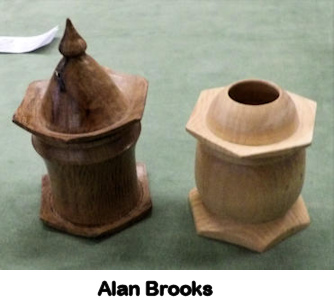
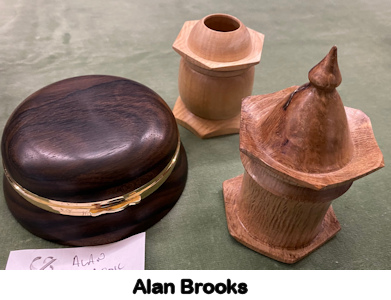
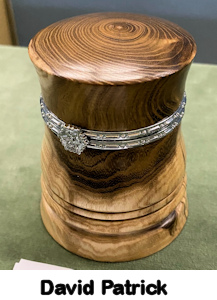

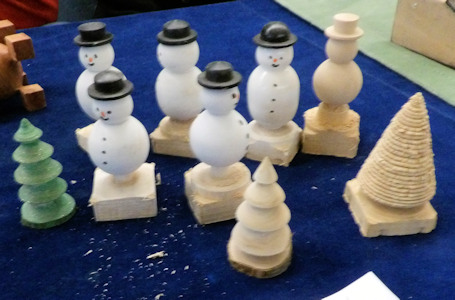
Paul's offset hollow form had caused
a few scratched heads as to how to hollow out through such a tiny access and
without leaving a large lump of wood internally furthest from the offset. The
secret was contrived by hollowing out from a larger hole disguised in the base.
The yew Satellite Dish was for a National competition he had entered many years
before. The oddity of the other dish was that it has 3 hob/upholstery nails as
feet, which needed pilot holes drilled and tags reduced before being hammered in
to avoid splits/pins showing through the bottom of the dish. The various
Christmas decorations were made over the last few Christmases by several Members
working in Paul's workshop. Finally, no home should be without a Frankenstein
Nut & Bolt for under one's hat.
Vic's wooden toy figure is his replica of typical designs from the
Erzgebirge (Ore Mountains) region of Germany close to the Czech border.
Originally, the area was populated by iron ore miners but when the mines ran
out, the population changed their jobs to wooden toy makers. Now they are the
premier wooden toy figure manufacturers in Europe.
John has turned an earring stand.
(click any below for close up view)

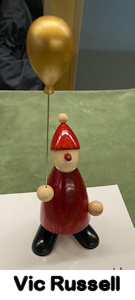
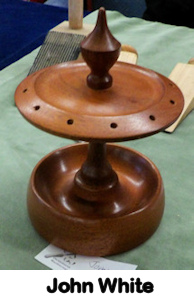
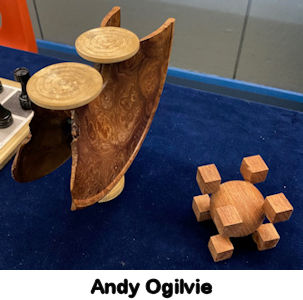
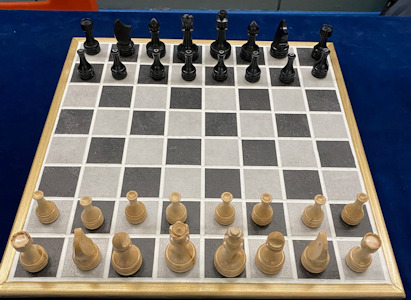
Andy is another who was
inspired by Jason Breach's samples and created an Arc in a polished decorative
wood as well as Squares & Sphere in another exotic wood, African Mulmanana. For
those with more time on their hands, you might consider making a chess set. Andy
had used Sycamore and had brought along his templates for the various pieces for
transcribing 'story lines'. See
Mike Haselden's July 2022 demo <HERE>
for explanation of use.
John Williams had brought in a bowl he has been gradually filling with
various turned fruits.
Rick's wedged door stops weren't particularly extraordinary but they are
something the Club's Sale Store is lacking so the Club would be grateful if
Members might find the time to make some. These examples were designed for
hard flooring hence the strips of rubber grip stuck on the bases. Rick advises
that he has bought a square metre of rubber and is happy to sell bespoke
dimensions - typically at about 25p per wedge.
(click any below for close up view)
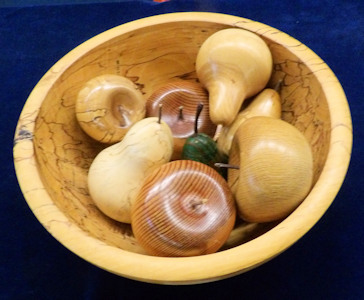
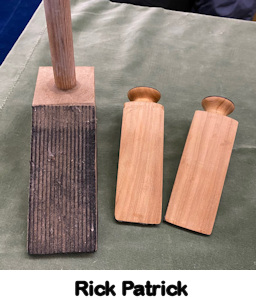
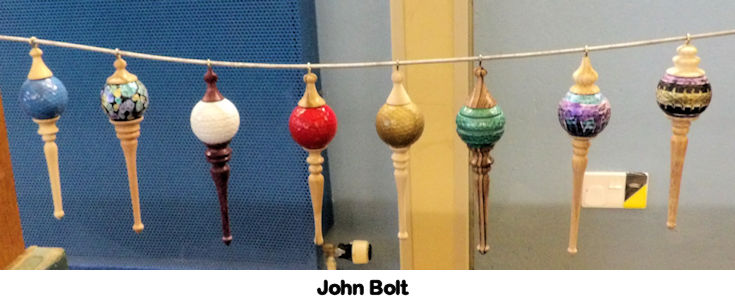
John has made more Christmas decorations this year but resorting to his new found supply of golf balls, duly hollowed out so they don't weight the branch down.
November 2023 -
Appraisal Table
with Andy Ogilvie
With Q&A's following Jason Breach's Pagoda Box professional demonstration, Andy proffered his apologies that he was limited with so little time to some excellent work on the appraisal table. However, he has submitted some notes for this report to augment his comments on the night.
(click any below for close up view)
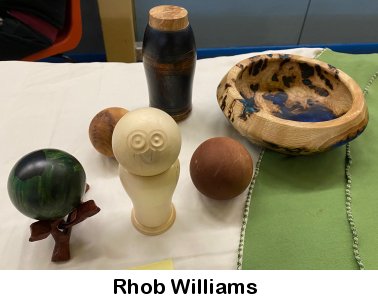

Rhob never seems to disappoint with quantity &
quality brought to the table; some excellent freehand sphere turning, one carved
with face (neat way to display with little stand/body). Box with very tight
fitting lid, embellished with decorative finish and stains. First attempt at
resin work on a very holey blank, well finished, no signs of bubbles, very good
effort.
A master class in natural edge from Rick's gorgeous piece of Cherry, well turned
and finished to show the natural beauty off to a very good effect. Thin
cyanoacrylate glue had been absorbed under the bark which should never
now become detached.
Andy had been given a gnarly cracked tree root as a challenge with this as the
result showing a lovely grain/figure. He had also created some dogs to fight
with his cats shown a few months before and finally, a toothpick snowman as per
newsletter - a Christmas challenge?
Nigel's well turned toothpick holder showed good control of dimensions to pack
cocktail sticks into such a small pot.
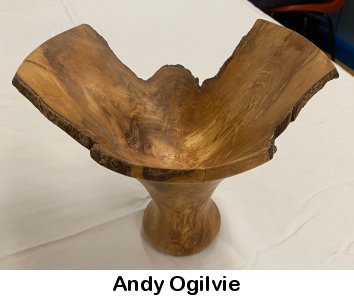


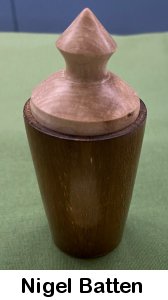
(click any above or below for close up view)
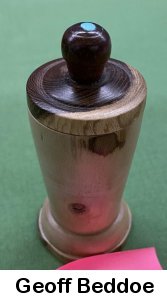
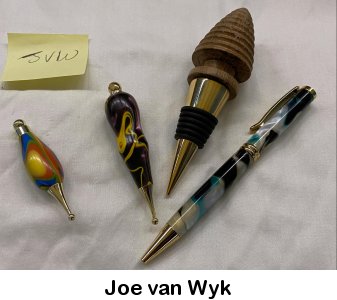
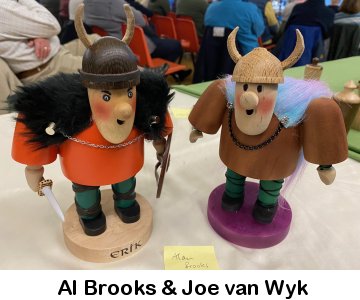
Geoff Beddoe's toothpick holder had
a smooth finish and again, good control of dimension to pack a lot into a small
space.
Joe van Wyk had achieved a stunning finish on his acrylic stoppers and pens to
show just what can be achieved with some of the kits that are available from
various outlets. Additionally he (and by coincidence, Alan Brooks) had each
produced Norseman smokers. Excellent mixed media project.
David Patrick's vase missed being credited on the night as it hadn't been named
but an interesting experiment with 'grassroot', turned nicely with a contrast
base to set it off.
Phil Walker made good use of contrasting woods to set off a vintage oil gauge,
well finished and a great gift for car enthusiasts (inspired by John Williams'
Saab speedometer turning earlier in the year)
John Bolt had brought in a selection of ebonised pieces with high voltage
etching filled in with coloured wax for a very decorative effect.
New member, Merle de Pearle, specialises in bobbins and brought some
examples of his intricate work, beautifully finished and made with his 'Bedan'
chisel.
Grateful thanks to Bill Gibson for two more string holders for the club stock
store.
(click any below for close up view)
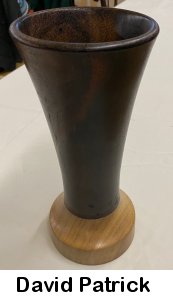

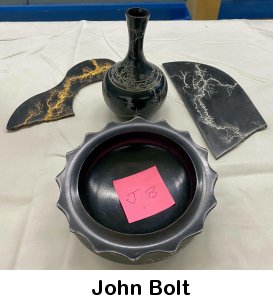
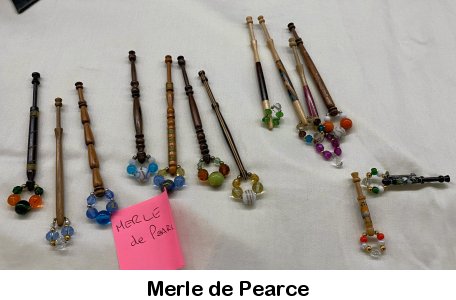
(click any above for close up view)
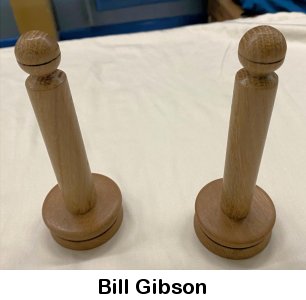
October 2023 -
Comp 4
Decorative Mushroom(s)
The consensus of the meeting was that entries for both tables should be complimented as the Club's best quality & quantity competition for quite some years.
TABLE A
(click any below for close up view)
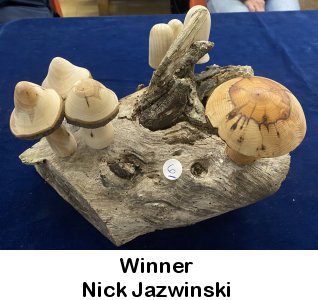
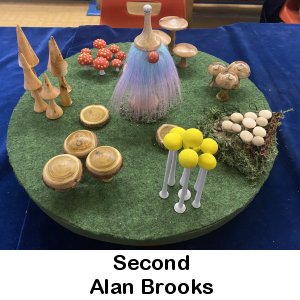
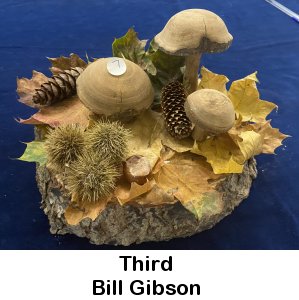
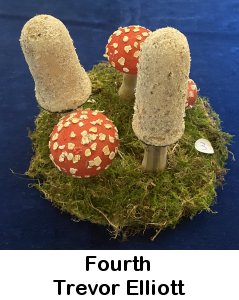
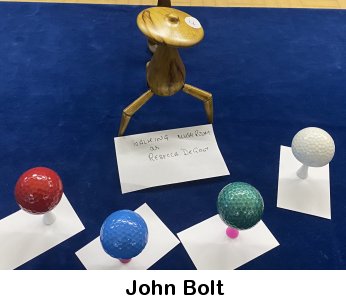

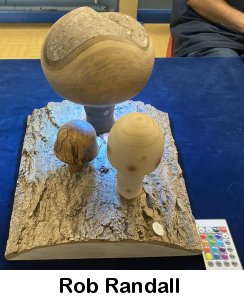
(click any above for close up view)
TABLE B
(click any below for close up view)
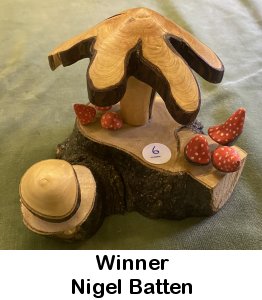


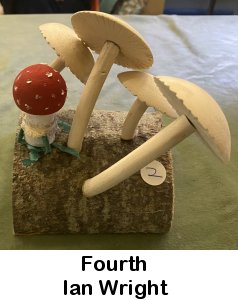
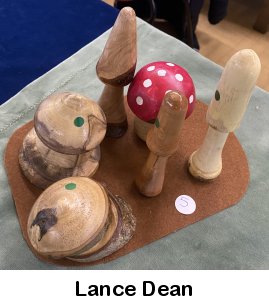

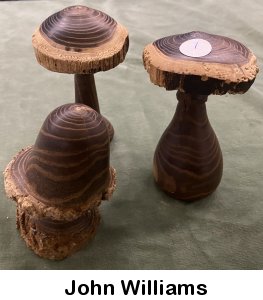
(click any above for close up view)
October 2023 -
Appraisal Table
with Andy Ogilvie
(click any below for close up view)
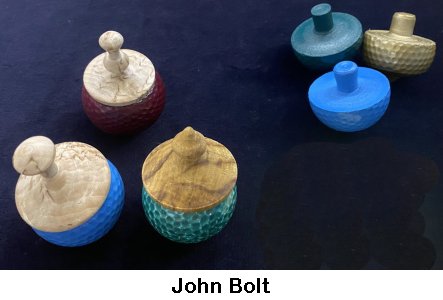
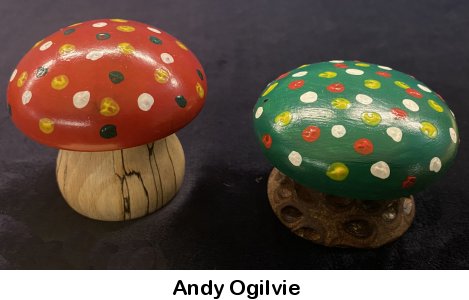
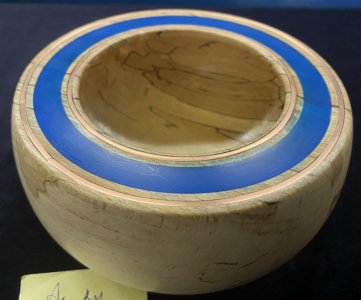
John has clearly taken a fancy to golf with 6
colourful spinning tops derived from golf balls. An interesting mix of colour
and constituents working with natural wood.
Andy's mushroom boxes were made with grand-daughters' presents in mind being
able to stow jewellery under the caps. He had also brought in a bowl with which
he was disappointed because despite remembering to seal the wood before applying
the resin, its blue colour still bled through into the adjacent spalted wood.
The general consensus was that more applications of sander sealer were required
before the resin. While trying to remedy the fault, Andy had to reseat the
copper ring (an earth wire stripped from electrical wiring) with araldite rather
than Cyanoacrylate glue he had used originally.
John Yale's fabulous off-centre turned mushroom was surprisingly not entered
into the competition. The finely turned discs working up the stem certainly
satisfies the 'decorated' criteria.
John's mushroom was a tryout to see how well pyrography could enhance his
decoration.
(click any below for close up view)
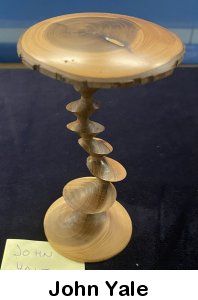
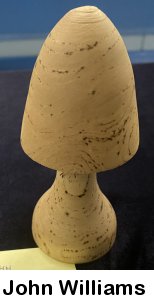
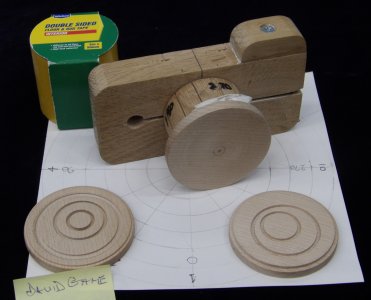
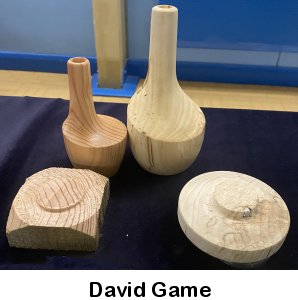
At first glance, you could be fooled that the piece
above is a mock-up of a camera with replacement lenses and spare film rolls!
It is in fact David's home-made method of off-centre turning. The 'camera body'
is a screwed clamp that grips the 'lens' which uses the 'film rolls' of double
sided sticky tape to grip the piece being turned. The 'lens' is annotated with
30º marks for rotating as desired. The clamp/'camera body' is held in a chuck
with only 2 opposite jaws fitted so that it can be slid left or right of the
centreline mark for the desired offset. Those 'replacement lenses' were just
examples of David's off-centred turning. The neighbouring photograph is of
further examples.
Thanks were extended to Lance Dean, Ian McClure, Joe van Wyk, Bill Gibson and
Alan Brooks for their contributions below of Dibbers, Spirtles & String Tie Kits
to the Club's general sale stock.
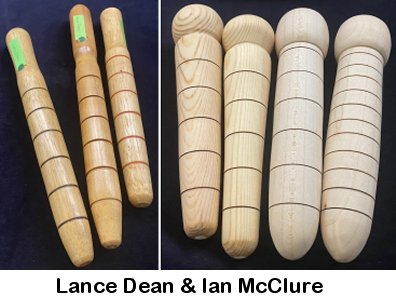
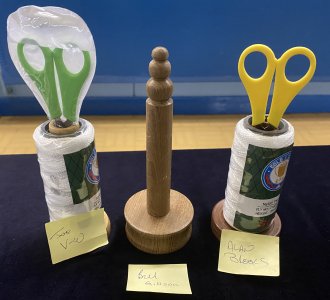
(click any below for close up view)
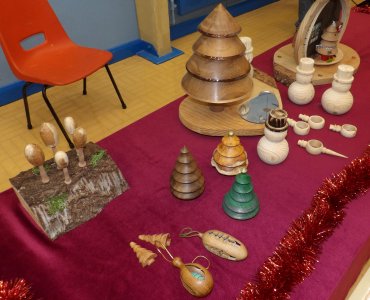

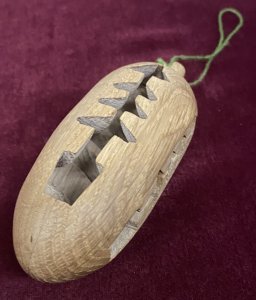
One table was set aside with Christmas turned goods for ideas/inspiration that Members might consider in the run up to Christmas. The majority of the exhibits were Rob Randall's with some others by Rhob Williams (inside-out turning) & Vic Russell (mushroom patch).
2023 -
Comp
3
Splash of Colour
TABLE A
(click any below for close up view)

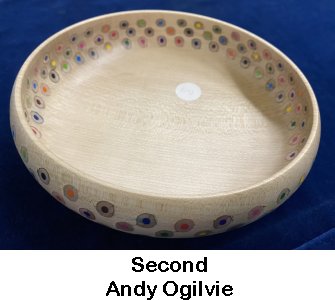
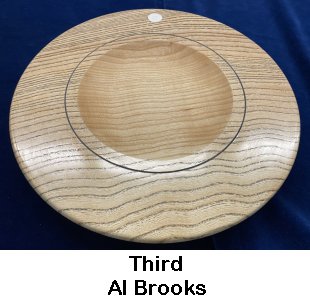

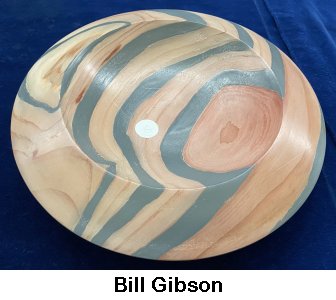

TABLE B
September 2023 -
Appraisal Table
with Andy Ogilvie
(click any below for close up view)
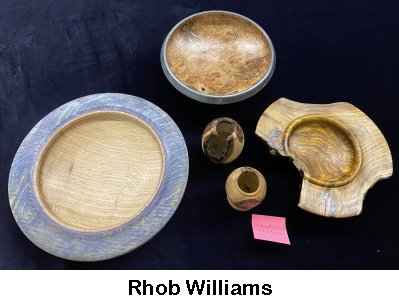
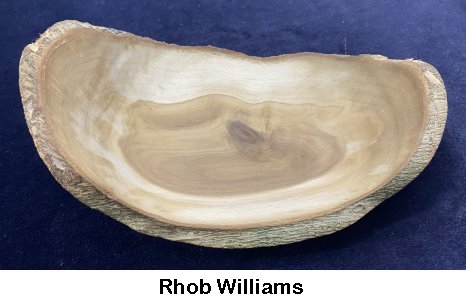
It had obviously been another busy month in Rhob's
workshop with his first attempts at hollowing. Following the Splash of Colour
demonstration, he had tried his hand at Liming Wax but his white spirits had
mixed with the wax rather than cure it. Paul Reeves advised that the spirit
stain could not have been dry nor been sealed before applying the Liming Wax and
that is why the wax has picked up the stain colour.
Alan's Kopy Kats were a copy of Andy Ogilvie (also copied from something Andy
had read) that were on display at Mudeford Arts Festival and which could have
been sold over a dozen times to passers by.
David has been melting some pewter in a ceramic crucible before pouring into a
flat ring mould so he could stick it to pieces of Laburnum & American Plane and
turn himself a goblet and mug.
Nick J's spalted platter was his canvas for showing his intricate embossed oak
leaves & acorns while Nick G seems to have pre-empted this evening's Mushroom
demo with some clean cut examples.
Andy had spotted a Resin Starter Kit from Yandles.
Together with some odd bits of wood around his workshop, this was his first
attempt at turning a resin bowl. The salt & pepper pots were also a try-out with
Banksia Nut with Milliput filler. He was aiming for white for salt and brown for
pepper but had only white Milliput. Apparently, you should colour the filler
with acrylic powder - Andy tried various acrylic paints, which ended up okay but
left his bench in a horrible mess.
Paul had produced 3 bowls from a single blank with the benefit of his bowl
saver. He called them his fruit, nut & chocolate bowls but left it to others to
guess which size for which foodstuff.
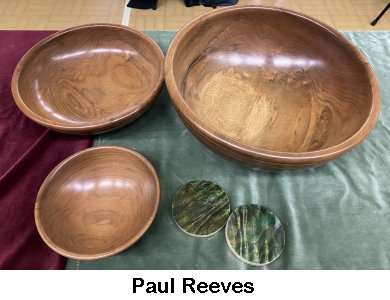
(click any above for close up view)
August 2023 -
Appraisal Table
with Andy Ogilvie
(click any below for close up view)


Chairman, Andy Ogilvie, welcomed 3 new members by
recounting his first Club meeting 4½ years ago with an expectation of being able
to turn something wonderful the very next day. That meeting had demonstrated how
to turn a wooden spoon but it took him a whole week before he had finished a
pair of salad servers which he had brought tonight - and they are still being
used today.
Following last month's various workshops, Ian McClure had been spurred on to
turn some pens, which he'd purposely avoided creating a shiny surface in favour
of sanding sealer, friction polish and Renaissance wax to leave a natural but
still durable finish.
Similarly with the Ornamental Lathe workshop, John Yale was moved to bring in
his concentric circle decoration done 10 years ago without the use of a
specialist lathe.
John Bolt had produced a pot-bottomed bowl inspired by our 'bowl from a plank'
series. John had achieved considerable variation of shape by making the walls of
the bowl as thin as he dared.
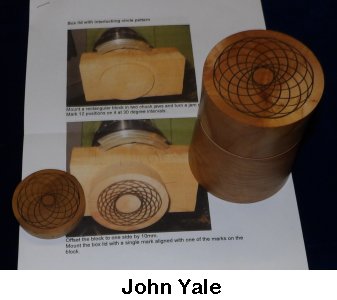
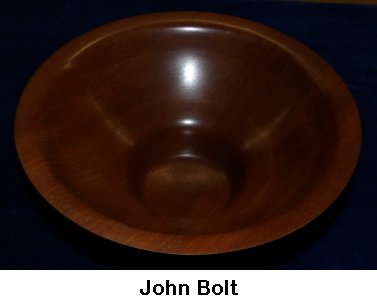
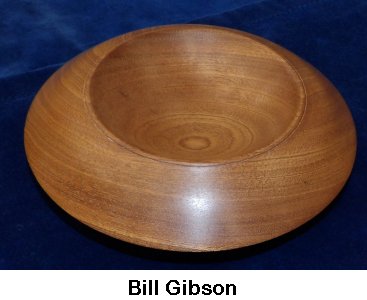
(click any above or below for close up view)
Bill showed a sturdy and stable design from unknown
furniture wood.
Rhob Williams had a prolific month at his lathe. I thought he had produced
5 pens but I missed another 6 under the flap; a tricky natural edge burr with a
unique foot produced from turning and chisel work; and a homemade recorder which
he hadn't finished 'tuning' in time for the meeting but could still produce a
melodious note or two.
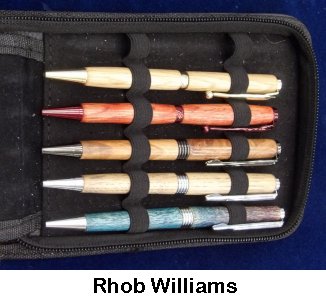
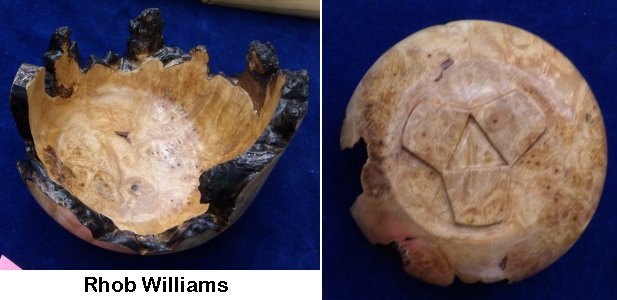
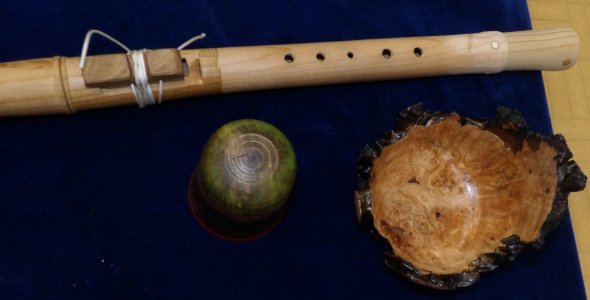
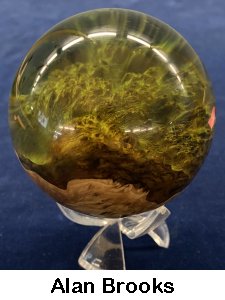
(click any above or below for close up view)
Al Brooks has recently spent time at a 'Resin
Sphere' tutorial course and brought along a spectacular example of his creations
enhanced by the clarity of the resin without a trace of cloudiness nor bubbles.
Paul Reeves had brought along a deeply figured Pine Wine Mat as well as an Oak
bowl he had turned as a demonstration at this month's Ellingham Show. The third
piece was a commission set by a rope maker for a set of three spheres of
specific calculated weight that would maintain a constant strain on the three
strands that were being twisted to form the final rope. Paul had turned an
initial Boxwood sphere to establish a diameter to weight ratio so he could then
calculate the appropriate diameter for turning the required weight.
July 2023 -
Comp 2
Kitchen Item(s)
TABLE A
(click any below for close up view)
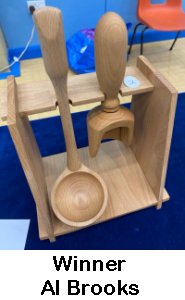
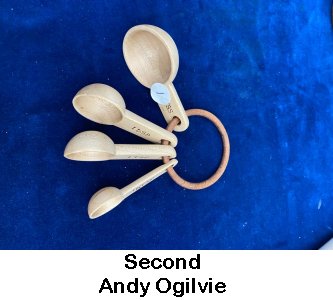
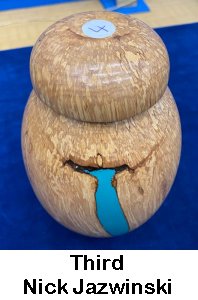
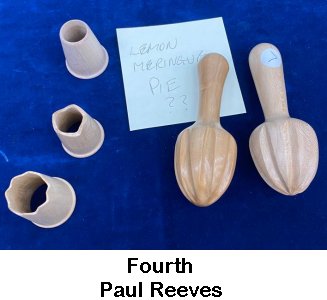

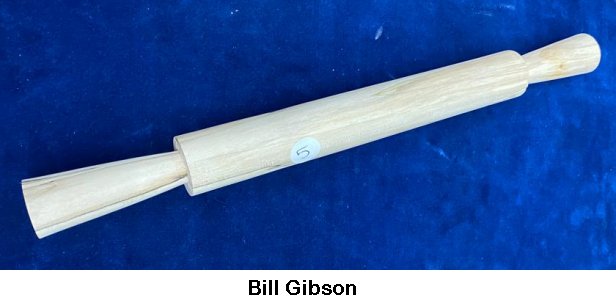
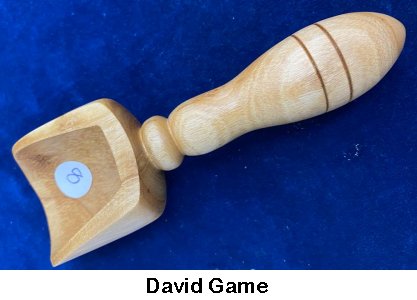
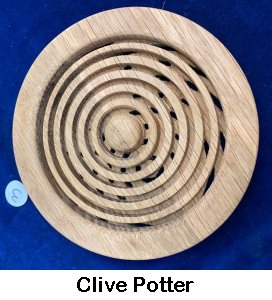
TABLE B
(click any below for close up view)
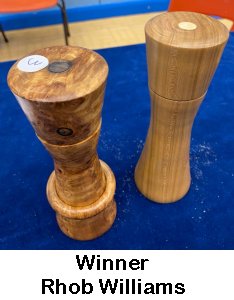
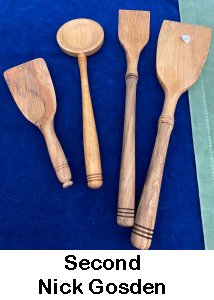

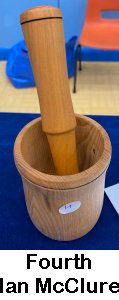
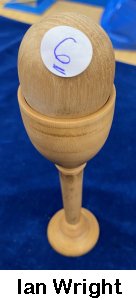
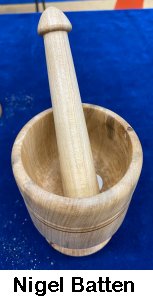
July 2023 -
Appraisal Table
with Paul Reeves
(click any below for close up view)

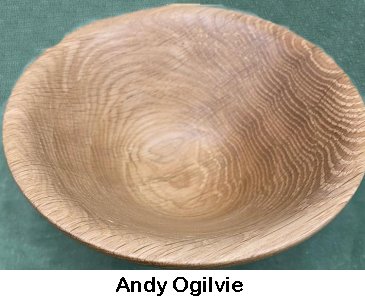
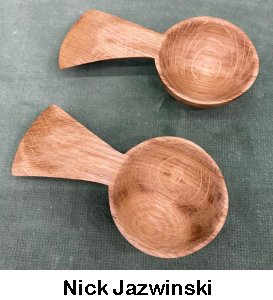
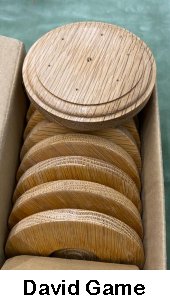
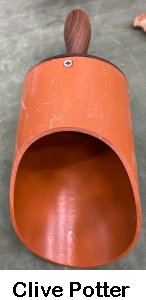
Joe had made several Kitchen Items for the competition and here were 3 that didn't make his final selection; spatula, spurtle & meat mallet tenderiser. Andy's 4-stepped 'bowl from a plank' with catching grain effect. Nick's 2-from-1 caddy spoons. David's bulk turning of Nail Puzzle bases for the Club's Sales stock. Clive's answer from items in his workshop for a resistant dispenser for his water softener salt; a Cherry goblet and pot for odds & ends or 'orts' (left-over snips of thread, cloth etc; orig referred to leftover food scraps); a spurtle. Rhob's ladle with Dogwood handle and Smoke Tree bowl (Cotinus Coggygria) which Paul warned as known to contain toxins causing skin irritation although Rhob stated he hadn't found it any problem. Rhob also brought a mysterious box which foxed most of us - it turned out to be a burger-patty mould!



July 2023
Workshops
Ornamental
Lathes - Andy Ogilvie
Decorative Finishes - Paul Reeves
Pens - Clive Potter
Lathe Care - Rick Patrick
Introduction to Ornamental turning with Andy Ogilvie
Ornamental Turning is a specialist area of
wood turning but in its variety of forms can also involve metal and many other
materials. The common element is the intricate shaping and decoration. This
became a fascination for Victorian gentlemen who would use their wealth to
commission lathes with as many accessories as they could afford from
manufacturers like Evans and Holtzapffel. Ornamental lathes are over 100 years
old and often over 200 years old.
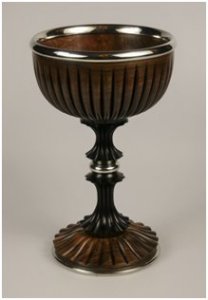
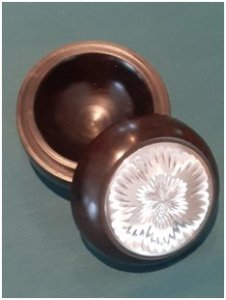
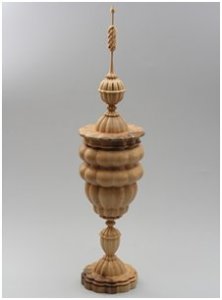
The quality of the machinery/engineering can be stunning and made all the more impressive with accessories which can be added to the headstock unit (eg cams and elliptical chucks), to the tool post (including overhead driven rotary cutters) and even parallel to the lathe bed to achieve spiral and/or shaping effects. In truth, many current lathe owners are enthusiasts of the machinery as much as its use for ornamental work.
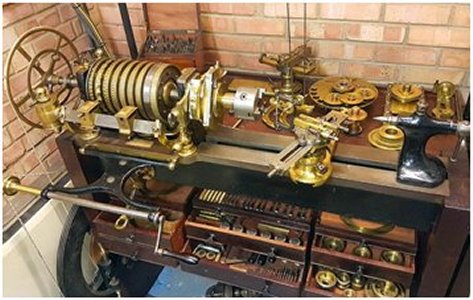
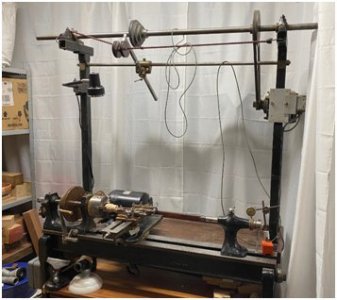
Andy’s personal set-up is very modest in comparison but it has the capacity to create many different decorative effects, spiral and form work, and elliptical work for example. Ornamental lathes were driven by a treadle originally but most now have an electric motor attached which can be used to drive the headstock or the overhead pulleys. A key element is a very good index plate so that patterns repeat accurately around the work.
To make his buttons, Andy :
• accurately faced a cylinder to a set diameter with a static cutter in
the tool post;
• cut interlinking circles with an overhead driven eccentric cutter;
• cut a central recess and then drilled the four holes;
• the slide-rest was then moved to an angle of 45º and an overhead driven
rotary cutter used to sculpt the front edge of the button;
• a normal hand parting tool was used to part the work before reversing in
a jam chuck with hot glue to finish the back;
• the buttons were dusted and then oiled - no abrasives as it would spoil
the sharp edges left by the various cutters.
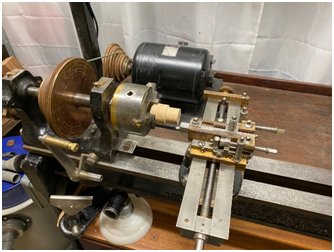
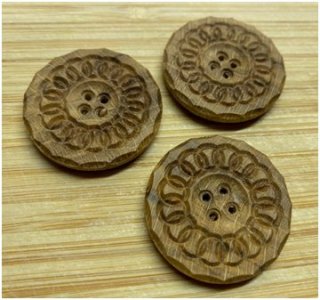
While clearing a workshop, Paul Reeves found an accessory for a normal lathe which is able to mimic a few ornamental effects and the common themes of accurate facing, centering, offset cutting, indexing and the use of depth stops were seen in its use, although of course, it achieves it in a very different way to an ornamental lathe.
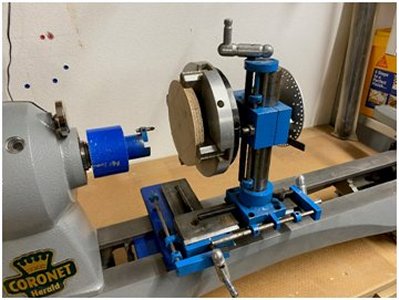
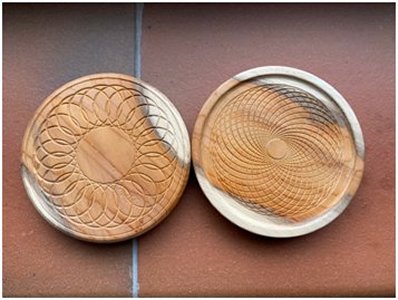
The two wine bottle coasters were
produced using this accessory.
Using ornamental machinery can be quite daunting for the first few times and
certainly patience and accuracy are critical, as is the capacity to juggle
indexing, depth, circumference to achieve the pattern that you are after.
Andy has yet to tackle using an epicycloid cutting-frame which can produce ‘spirograph’ type patterns – maybe next week!?
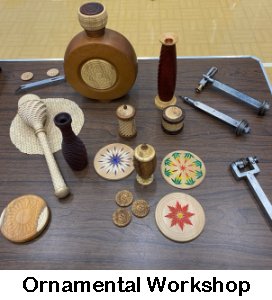
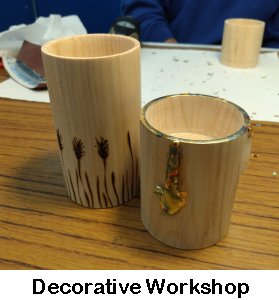
(click any above for close up view)
June 2023 -
Appraisal Table
with Paul Reeves
(click any below for close up view)
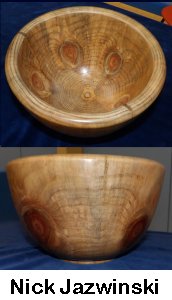
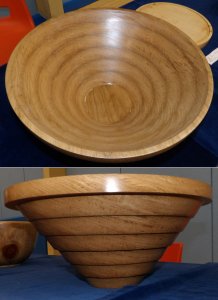
Nick's Monkey Puzzle bowl was cut down several years
ago and developed a blue stain mould. Paul commented the staining is common,
takes ages but the change from maximum darkening to unworkable soft wood happens
suddenly. His 7 layer bowl was from a single plank. Nick commented that both
bowls, being so deep, had proved to be difficult to finish the inside bottom. He
admitted he had left the outside showing as prominent bands because he was
concerned that the walls were getting too thin. Paul suggested that bowl
gouges with 70º to 80º bevels can help but various hollowing tools also work
well.
Joe also had a go at last month's demo of Bowl from a Plank.
Rhob had brought in segmented Pierced Earrings that were a birthday
present for a loved one, a Bowl from a Plank and an Acorn Box turned
out of Holly/Holm Oak, (also known as Evergreen Oak as foliage has evergreen
leaves akin to Holly).
Nigel's Bowl from a Plank of plywood was striking and Rick's Maple chopping board looked too good to use. He had finished it with Tung Oil - for the sole reason that the tin had been in his cupboard for over 10 years and he felt he ought to use it sometime.
May 2023 -
Comp 1
Vessel with Finial(s)

(click any below for close up view)

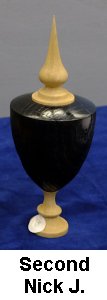
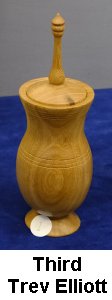
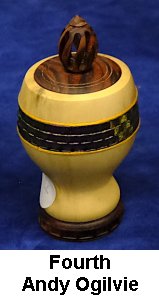
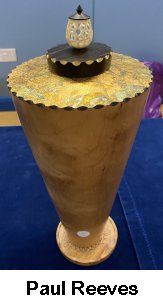
This competition had been set
following a demonstration by professional turner Les Thorne making a box with a
reversible finial while spotlighting basic gouge work and planning
considerations along the way. Les' demo piece is far left in the top
photo. All bar Paul's entry had reversible finials. Paul Reeves appraised
the entries.
Alan Brooks won with a trophy style in Beech with trims in Padauk. The join
between the base and the hollow form was unbelievably tiny - Alan explained that
it had been reinforced with a pop rivet pin.
Nick Jazwinski entry had succumbed to a change in environment since being
turned because by the end of the evening, the knob shaped finial within the
piece was getting tighter & tighter to get out of the hollowed entrance.
Andy Ogilvie's vessel was finished with some foil decoration and he had included
the remnants of his first finial which had been perfect until it had
inadvertently dropped to the floor and exploded into a dozen pieces.

(click any below for close up view)
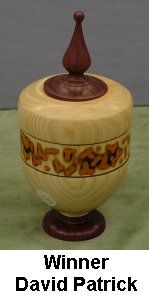
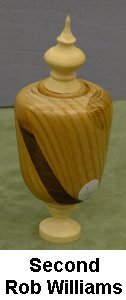
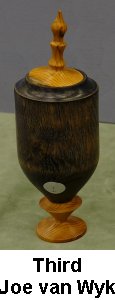
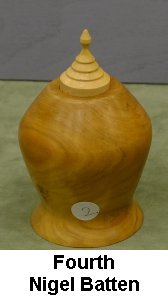
David Patrick's entry had originally been planned to
incorporate a pierced scorched decoration but was subsequently rejected and
successfully rescued with the use of Milliput epoxy putty.
Rhob Williams has only recently joined the Club and was a worthy contender with
his smart combination of woods.
Joe is renown for his unusual wood treatments and this time it was vinegar and
wire wool on a piece of Oak. Paul warned that the smell of this process is
probably best completed outside of the family home.
Nigel had used Cherry branch wood for his design.
May 2023 -
Appraisal Table
with Andy Ogilvie
(click any below for close up view)

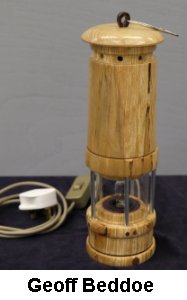
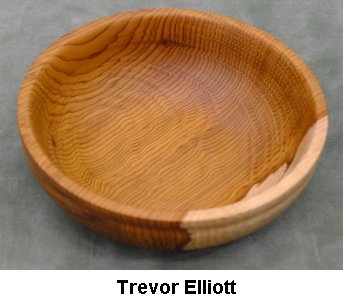
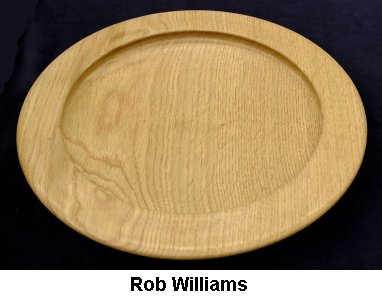


(click any above for close up view)
Julian's collection of bottle
stoppers in natural edged Ash left some of us pondering who has that many wines
open at once! The kits came from Pro-Craft and the finish on the natural display
was indeed striking.
Geoff's welsh mining lamp had a couple of hidden finishes. Not only did the bulb
illuminate like a flame but the upper body could be unscrewed using a 12tpi
thread constructed with a newly acquired Simon Hope Easy-Set Threading Jig.
Trevor displayed an impressive rippled Yew bowl and new Member, Rob Williams,
brought along his air-dried Oak platter.
Andy's paint-dragged Beech bowl was quite dramatic while his ornamental glass
mats were not done using his ornamental lathe but instead with an add-on to a
modern lathe. More with this to be demonstrated in our July Workshop.
Although Rick's 2 pieces in burr Oak
were both finished with a couple of coats of lemon Oil, they ended up with quite
different shades of brown despite being adjacent to one another from the same
plank.
Paul had brought in a threaded urn in Ash but with the lid fitted with an insert
which provided a more resilient thread.
(click any below for close up view)
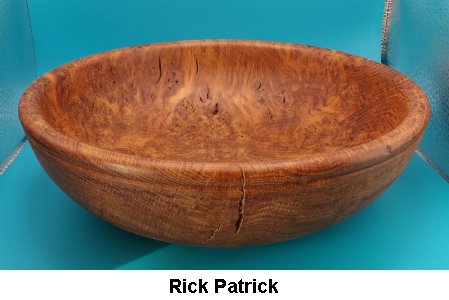
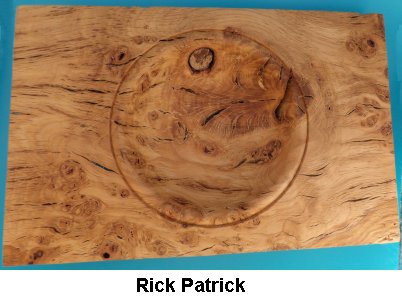
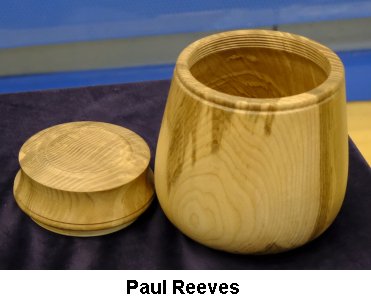
(click any above for close up view)
With Les Thorne giving the Club a Professional Demonstration, there was insufficient time to give appraisals but below were the items displayed.
(click any below for close up view)
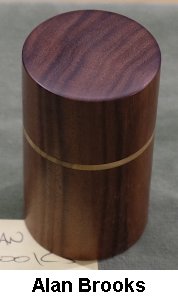

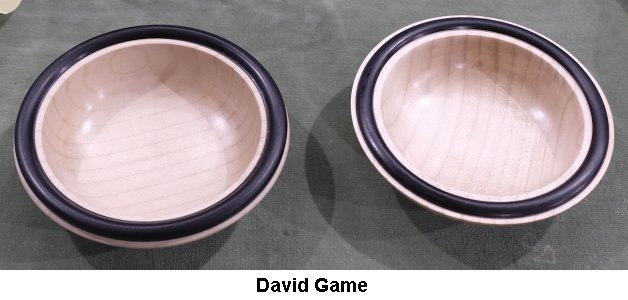

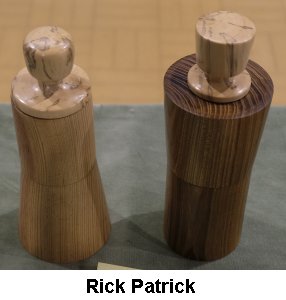
(click any for close up view)
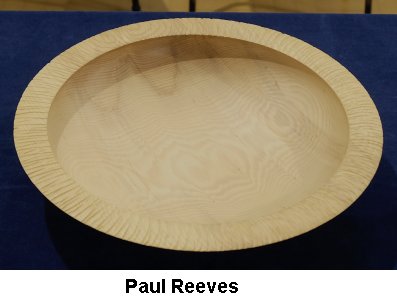
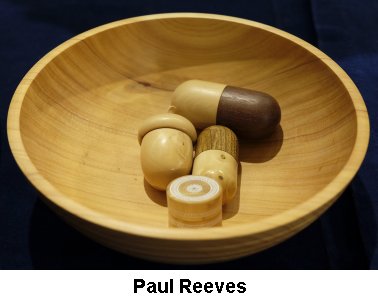
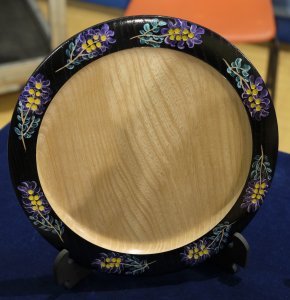
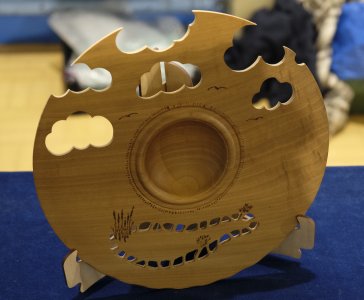
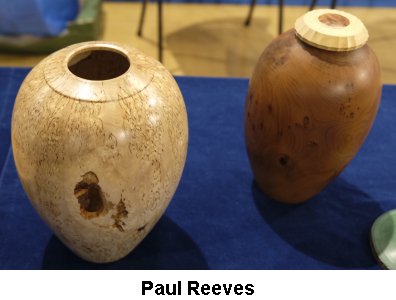
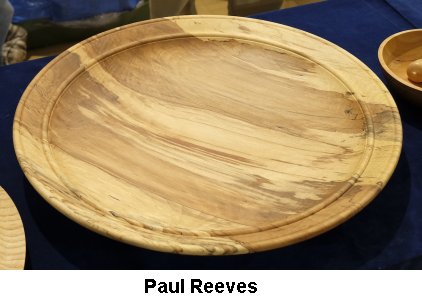
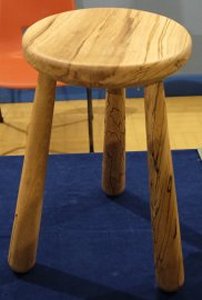
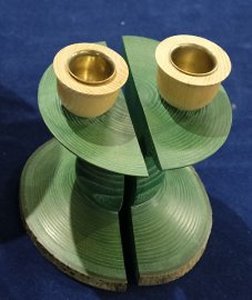
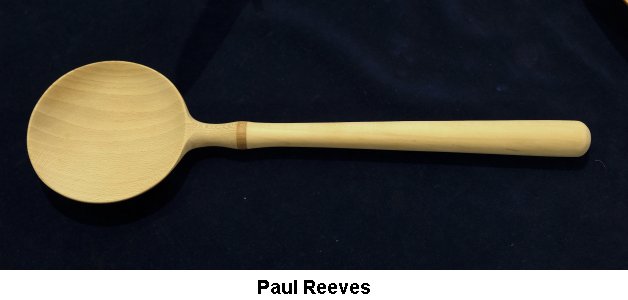
(click any above for close up view)
March AGM 2023 - Display Tables
The Wood Sale

(click any photo for close up views)
The Committee gave their reports.
After some 12 years of the same Annual Subscription, an increase of £5 was proposed, which will take effect from the year starting April 2023.
The annual awards were presented (see e-Newsletter for photos).
Clive Potter and Richard Slee have stood down from the Committee and Allan Rae
joins.
The Wood Sale was well stocked as usual and this year, with a selection of Burr
Oak, English Box and Redwood.
The Chairman had asked Members to bring in some of their favourite pieces they
had produced this year and some are shown below.

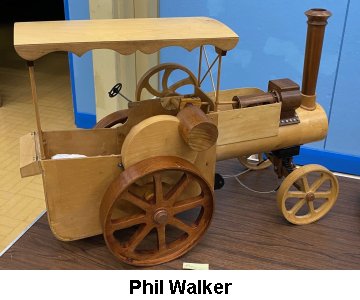

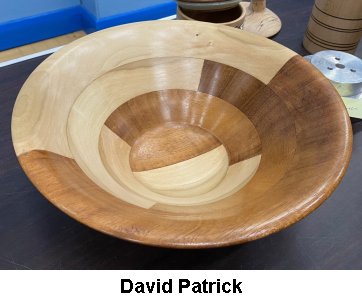
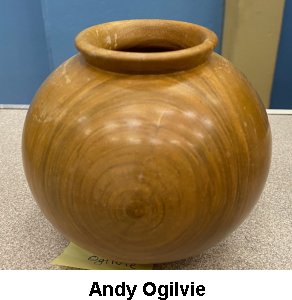
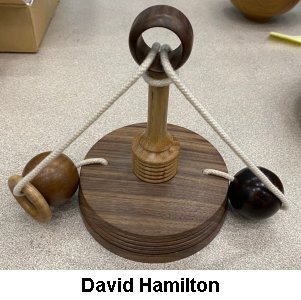
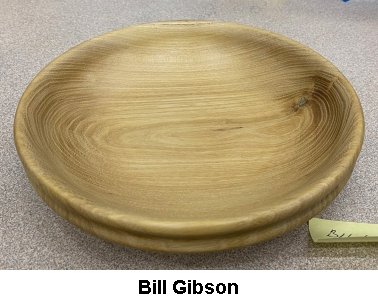

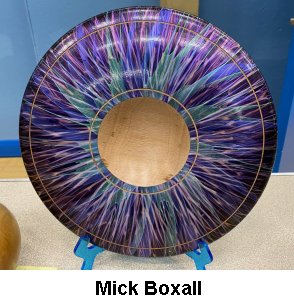
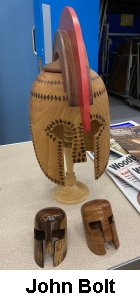

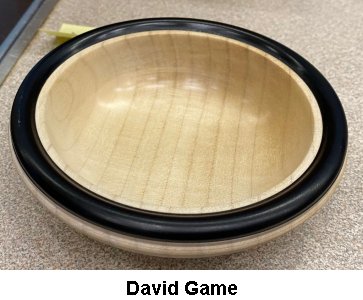
(click any above for close up view)
February 2023 -
Comp 5
Buttons
TABLE A
TABLE B
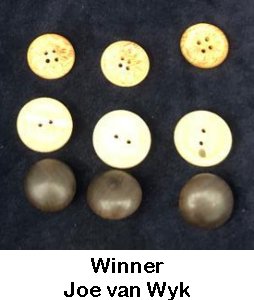

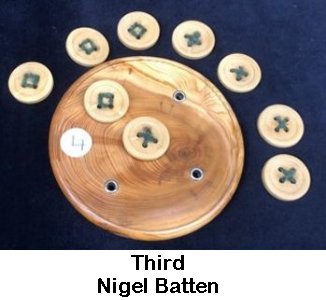

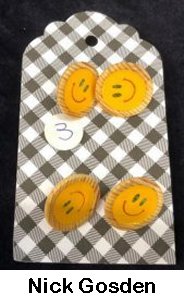
February 2023 -
Appraisal Table
with Paul Reeves
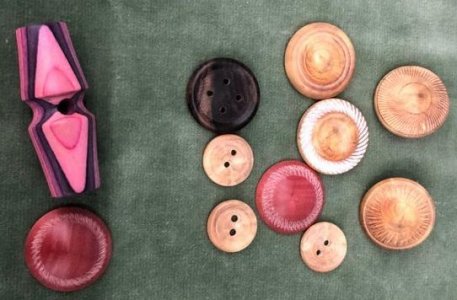

Paul Reeves had brought last month's demonstration
buttons after completion at home. There were also two Pink Ivory buttons that didn't
match the three he had used for his competition entry. When highlighted with
Gold Gilt cream, the decoration clearly shows different patterns made; this
lack of consistency is common with a chatter or a knurling tool like the
Decorating Elf that Paul had used. However, there were still 3 out of the 5 that matched
well. Next was a 'Guiro' (a handheld percussion instrument)
made from American Plane with a Rosewood playing stick.
The night-light holder was a piece of spalted burr Beech rescued from his
firewood pile which demonstrated that sometimes a natural split in a piece has
far more character than a turned rim. When it comes to goblets, Paul
prefers very thin examples. One was turned from a discarded pine curtain pole,
which judging from the tightness of the annual rings, originally grew in a cold
region of the world.

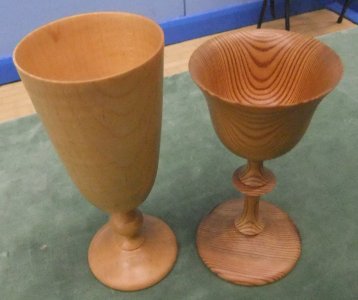

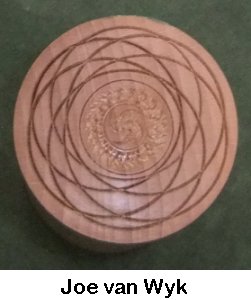
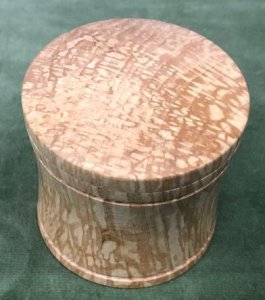
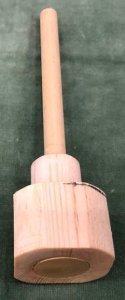
Joe van Wyk had used a scroll chuck to
produce a fine ornamental lid to his box. David Game had made good use of
some rippled Maple for a stunning box and brought along his home-made Jamb Chuck
he had used as his button finisher for the competition; once he had finished one
side and parted off, he finished the reverse with the chuck holding the spigot
and the dowel portion disappearing inside the headstock, ready to flick the
button out of its jamb.
Rick Patrick had been commissioned by family to turn a bowl sturdy enough
for car keys. He had selected some Apple cut from an old orchard over 10 years
before and for the ornamental exercise, decided to wallop it with a Ball Pein
Hammer followed by a bright shade of Gold Gilt. His other piece was from a
fallen Hornbeam from a neighbour's woodland that had blown down over a year
before and was showing promise of some interesting figure within but hadn't turn
out quite as exciting as hoped.
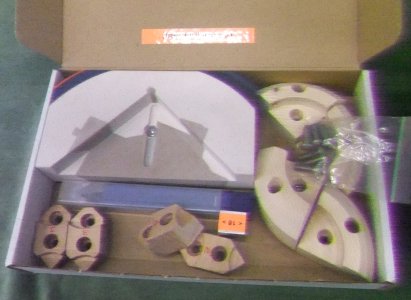
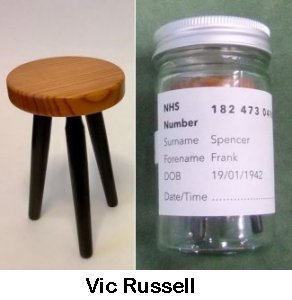
Vic Russell has been dissecting a 10-pin
bowling ball all for a good reason; having turned bespoke wooden jaws in the
round and accurately sawed them into quarters, this was a jig to position them
precisely for drilling securing holes to connect to jaw carriers. He had
also found in the props cupboard of 'Some Mothers Do Have Them' a stool sample
for the lead character.
Some more work from Andy Ogilvie's Ornamental Lathe. It probably took some
time to do each one but they certainly are a close match. Finally, 4 examples of
Ribbon Streptohedrons created by John Bolt.
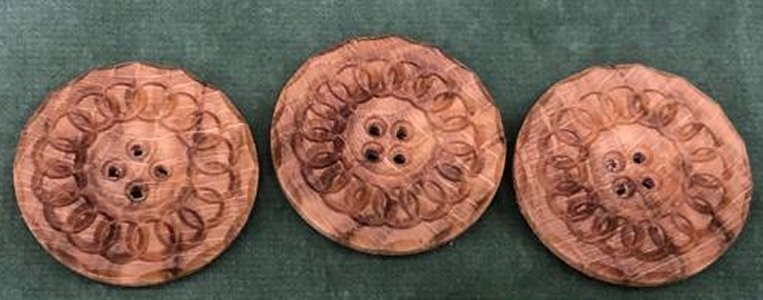
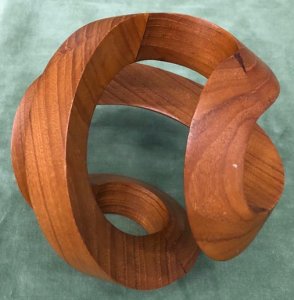

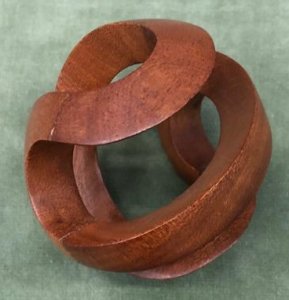
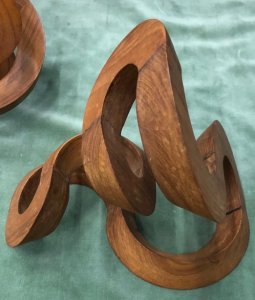
January 2023 -
Appraisal Table
with Andy Ogilvie
(click any below
for close up view)
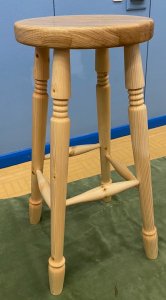
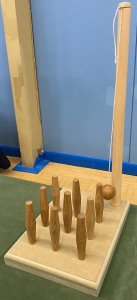

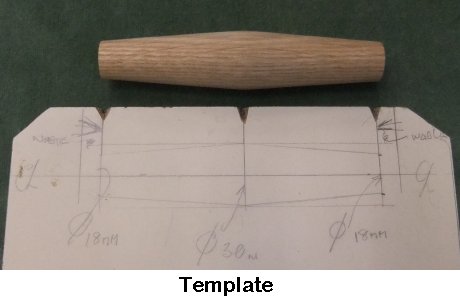
David Game had brought in 2 fine
examples of salvaged worktops highlighting his carpentry skills - the stool had
uniform matching decoration on the various components while the Bar Skittles had
perfectly flush fitted Laburnum insets for the skittle positions. His
Skittle template had cone-shaped wedges which allowed very accurate marking up
with a sharp pencil.
Andy's first piece was made using an Oval Chuck on his ornamental lathe,
which works by the
wood (and the chuck holding it) being moved towards/away from a fixed cutter by
a sliding mechanism twice every turn to create the oval shape.
The stopper is of Faux Ivory, which he had intended to have as a thin curved
oval shape to match the top of the wood. Real Ivory is often ultra thin but
clearly Faux Ivory is not as sturdy, so he had to resort to creating an intricate
decoration out of the remaining stem. Andy Ogilvie's hollow form was of Fig
which had numerous splits within (somewhat similar to inside Eucalyptus). After
turning, he had considered trying to fill the splits but realised it would have
been easier to do so before the finishing cuts.
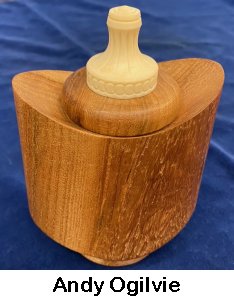
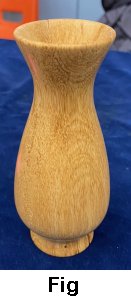
(click any above for close up view)
(click any below for close up view)


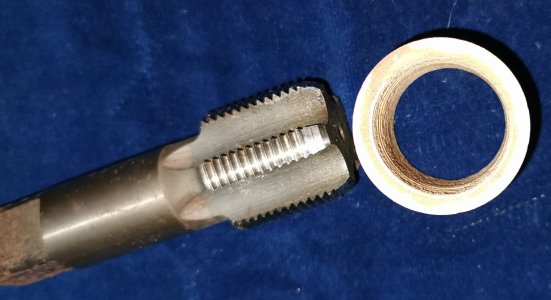
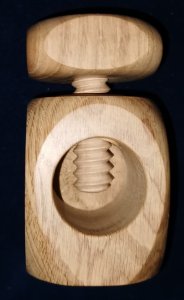
(click any above for close up view)
Following last month's demonstration of thread
cutting with a Screw Box & Tap, Paul Reeves had brought in some alternative
(more economic) cutting tools. If you look at the enlarged photo of the
'Nut & Bolt' tool, you will see angled grooves in the ends of the 2 parts so
that the waste wood has somewhere to get out of the way. Paul had created these
using a thin metal grinder disc attached to his drill. These nuts & bolts
were metric sizes, which produce quite a fine thread; if you can find them,
Whitworth size have coarser threads.
Paul also brought an example of a square sided Nut Cracker in response to a
Member commenting that someone in his family suffered from poor grip. With
both the top and the body being left square, the action was a lot less
difficult.
There were 2 examples of spheres with dome decorations achieved by being held in
a Jamb Chuck. Paul warned that this was a difficult job to know when to stop
putting in more decoration - he found he could always see an area he thought was
too big compared to the rest.
There was a Cedar and Spalted Holly bowl from a competition several years past.
It is surprisingly light because the Cedar body had been hollowed out and
sharply undercut leaving a lip for the thin sided Holly to be glued in.
Paul thought the beauty of this was that he had easy access to hollow out and
didn't have to worry about how smooth or rough the inside work was!
Lastly, Paul had brought in a beautifully figured bowl of Maple Burr.
(click any below for close up view)

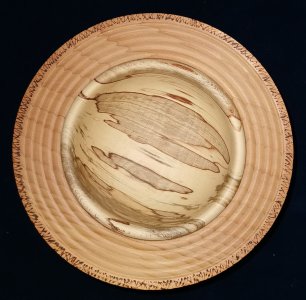
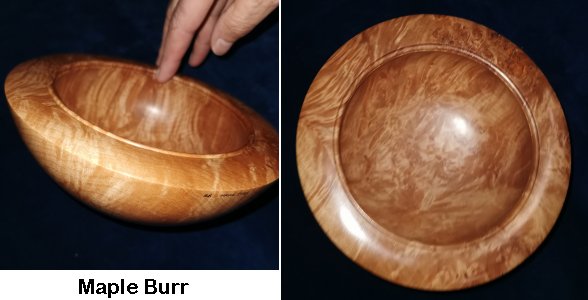
(click any above for close up view)
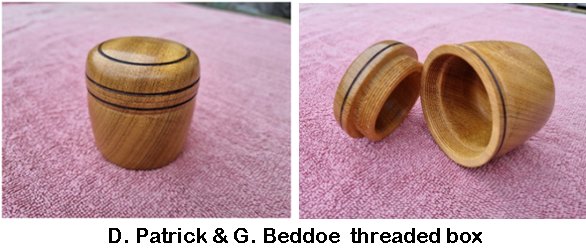
Cold weather and travel distance put paid to January's
Meeting for David Patrick & Geoff Beddoe. However, they had produced a couple
pieces that they thought might be of interest. The small box with a
threaded lid was a collaborative attempt and made of Sapele, 70 x 70mm. The
Simon Hope Cutting Jig was straight-forward to use and made an accurate 16tpi
thread without suffering serious damage to the thread peaks. The kit also
included a 12tpi spindle, which they have yet to experiment with.
The 250mm diameter segmented bowl had been made by David from two scrap
plank ends. The light-coloured wood is Tulip, and the dark wood is Mahogany. The
method was simple with only two rules :- The bandsaw cut angle must be 45º
AND The
distance between the cuts must be equal to the thickness. This is a great
introduction into segmented turning, easy to prepare and cost effective.
The replica oil lamp was made by Geoff Beddoe from a combination a Monkey
Puzzle body and a spalted Beech base/lamp carrier. The intention had been to
hollow out the inside of the oil reservoir, but Geoff found the wood was too wet
and pithy despite more than 18 months in the workshop and thus was left solid.
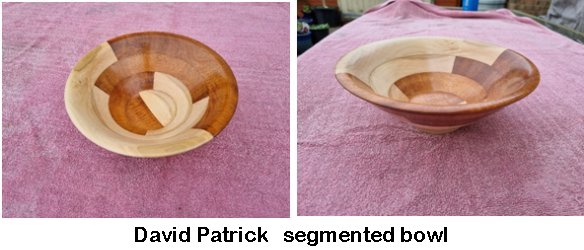
 (click this
photo for close up view)
(click this
photo for close up view)
December 2022 -
Appraisal Table
with Paul Reeves
(click any below
for close up view)
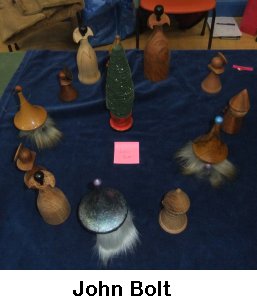
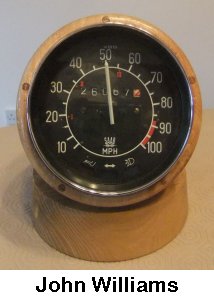

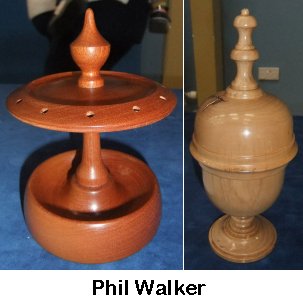
(click any above for close up view)
John Bolt has added 3 identical new Christmas tree
decorations to his collection virtually every December and brought a selection
of past & present Gonks, Angels & Xmas Trees.
The Son of John Williams had bought and renovated the Saab 95 which had
been his first car in 1987. As it was his 50th on the 26th
June, his Wife decided to find another Saab's speedo and 'clock' it to show his
birth date in the mileage and the pointer against his age. It took a long
search and discrete conversations with elderly/retired car dealers who would
admit to being skilled in the 'ancient art' before the job was done. Dad's
job was to turn a hollow form and base ring to display the end result.
Phil Walker's snowmen were striking for their delicate Padauk 'carrot'
noses and their convincing rivet eyes & buttons. One assessment about his box
with a finial lid was that the lid felt out of proportion and made the piece
appear top heavy.
Ordinarily, bowls are turned thin to infer a delicate beauty but Alan
Brook's Robinia Burr with its thickness of natural edge and sides magnifies the
interesting contrast of sapwood to heart.
Andy's 4 offset-turned Ladies were done as an exercise to discover which
different shape, colour and texture worked best.
Julian Hellebrand is working towards making a Nussknacker (German
levered-mouth nut cracker). This was a foot high trial version without the mouth
mechanism but great attention to decorative detail.
(click any below
for close up view)
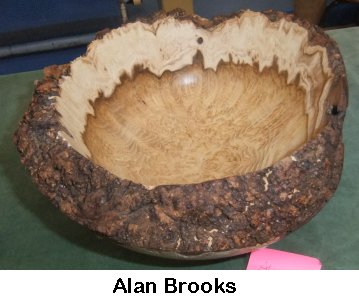
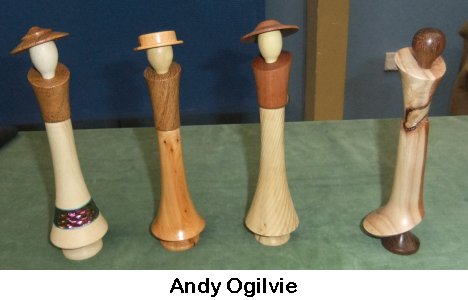
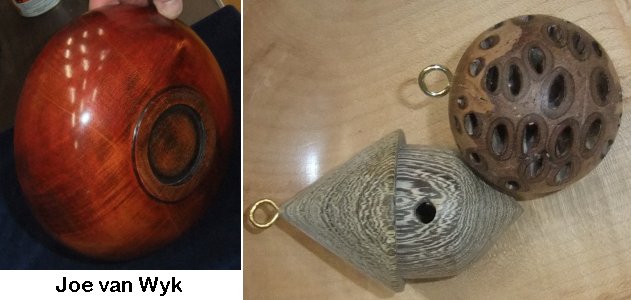

(click any above for close up view)
November 2022 -
Comp 4
Animals
TABLE A
(click any below for close up view)
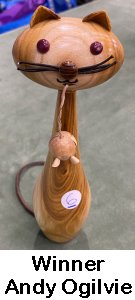
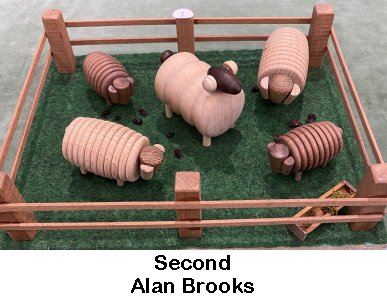

TABLE B
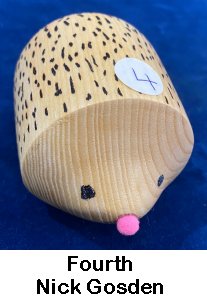
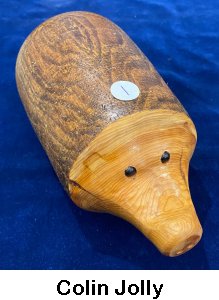
(click any above for close up view)
November 2022 -
Appraisal Table
with Paul Reeves
(click any below
for close up view)
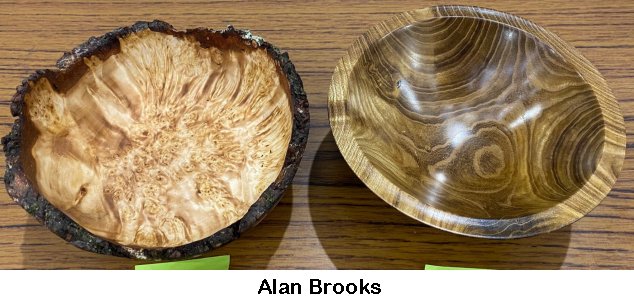
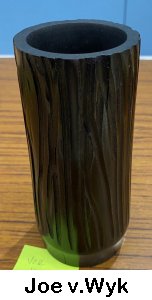
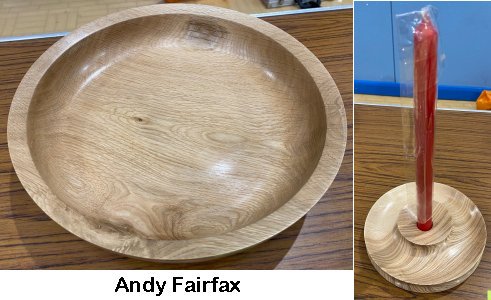
(click any above for close up view)
Alan Brooks had brought two 6" bowls superbly
finished to show off their grain. The bark of the natural edge had to be
supported by superglue, which was subsequently treated with accelerator or
allowed to dry before restarting the lathe.
Joe van Wyk's 8" vase had been 'arbortech-ed' and ebonised with metallic spray.
It is easy to agonize how much and how random is enough for each cut of the
blade but thankfully, one's initial unease always seems to end in an impressive
and coherent overall effect.
Andrew Fairfax's bowl had a great shape on the outside but because of the steep
sides, he had found difficulty getting a smooth inside bottom. To get rid of
these undulations, Paul suggested one (or a combination of ) - less steep sided
design; a gouge with a greater bevel angle; hours with a block sander.
Andy's candlestick had good sharp details in its coves obtained with a round
scraper and small gouge.
Jerry Lewis had some magnificent pyrographic
examples. He had used
artist quality wood dyes on the beautifully coloured tablemat but warned members
that after applying acrylic or water colours to bare wood a cellulose
sealer should be used as other sealers may lead to unwanted bleeding of colours. Upon being asked how long the mat had taken to decorate,
apparently "a short day's work!" His eye-catching Remembrance bowl with
colouring pyro and barbed wire insert came with a 'handle carefully" warning.
Andy Ogilvie's spalted white walnut crotched vase had a remarkably even wall
thickness although Paul noted that the inside would have benefitted by further
smoothing with the help of more coats of sander sealer to stabilize the surface.
Paul explained that with his own bowl, he had deliberately left different levels
and areas on the outside to allow for decorative effects such as texturing,
pyrography etc
David Hamilton's puzzle might have been a month late but very well made
incorporating a number of turned elements.
(click any below
for close up view)

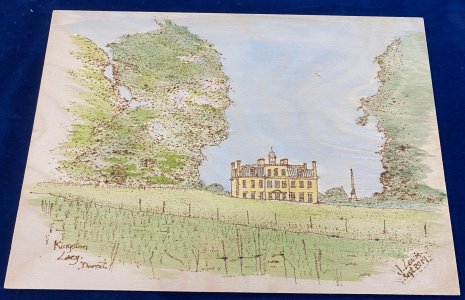
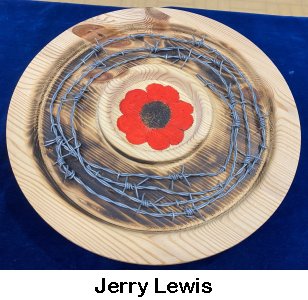
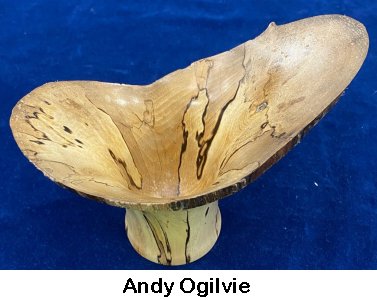
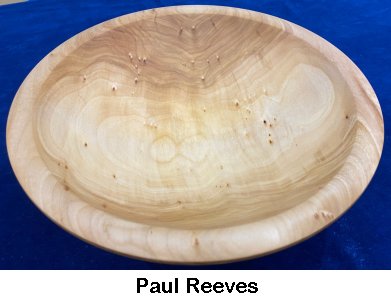
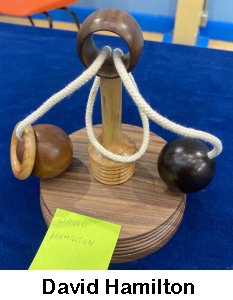
October 2022 -
Appraisal Table
with Andy Ogilvie
(click any below
for close up view)


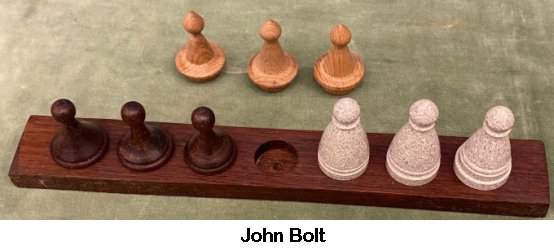
Andy expressed delight that a couple of
Members had attempted last month's Kilner challenge. He was impressed with the
elegant slimness of both lids. Joe van Wyk had turned his jar quite thin which
made for a comfortable empty weight. Nigel Batten set off his decorated lid with
a matching base plate; he was also commended for including sweets!
John Bolt had been practising duplicate turning and then constructed a
playing surface for various 'pub games' but didn't seem to be keen to progress
to turning a chess set although draught pieces could be a possibility.
Alan Brooks had turned a Banksia Nut into a
Bullet Box with Padauk for the box joints and African Black Wood for the bullet
head. The joints between the Banksia and Padauk were very accurately done and
even the base had been decorated to look like a bullet primer. Next to that was
Alan's first attempt at an open spiral. He had used a 'surform' round file and
achieved a uniform gap all round.
Mike Woodhouse had also turned a spiral with a cunningly disguised candle
holder having a candle cup at whichever end was upright.
Andy Ogilvie had also turned a candlestick on his ornamental lathe. With
mathematical precision, each flute of the bottom plinth and top head coincided
exactly with the peak and trough of each spiral cut; and this was achieved while
following a bulbous profile of the column.
(click any on blue cloth for close up view)

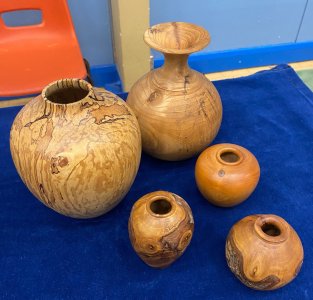
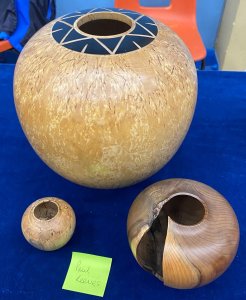
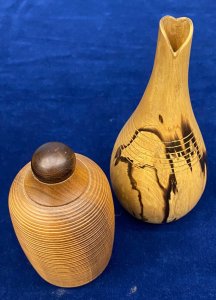
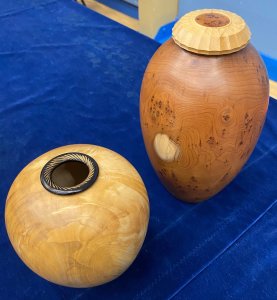
Paul Reeves had brought in a selection of
hollow forms to highlight problems facing any new turner. In Paul's early
turning days, there weren't specialized tools available so everyone started off
hollowing small pieces, which had the advantage of learning how to avoid
'blowing' the piece apart without it costing a fortune whenever your tool broke
through to the outside. He then mastered thinner walls before progressing to
larger pieces. The largest of the 3 forms in picture 3 above is a prime
example; this Masur Birch wood (blank bought for about £80 just after the
Millennium) was one of Paul's early large hollow forms and although lovely to
turn, it weighs too much because the walls should have been a little thinner
These days with Rolly Munro, Woodcut or Crown specialized ring, hook or carbide
hollowing tools, it is easier to tackle large pieces but harder to grasp the
skill of uniformly thin walled vessels with their consequent lightness.
In the same picture 3, the Yew form with a cut in the side was undertaken with
more experience. There is only one way to approach the hollowing out; starting
from the top opening, hollow out the first half-inch or so and sand before
progressing to the next half-inch and sand etc so that the rest of the form
below your hollowing/sanding is still solid and less likely to flex. These days,
it is common to support the outside with several taut wraps of cling film.
The beauty of the side hole allows one to be precise with uniform thinness.
Probably the best way to hide the finish of the inside of your hollow form is to
leave an opening so small that no finger can get down it to check by feel. This
will require taking the neck out further down the vessel to access a larger
diameter in order for your tool to hollow out. The neck is then refitted with
the help of some decoration to camouflage the join. It is also advisable
to flare the inside of the neck at the bottom to make any view down the spout
more natural. An alternative way to mask the internal finish is to coat
the inside with matt black paint, although beware that some porous woods might
bleed through some of the black paint, particularly if thin walled.
September 2022 -
Comp
3
Puzzles & Tricks
TABLE A
(click any below for close up view)
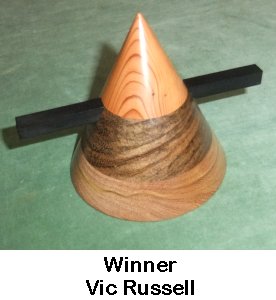
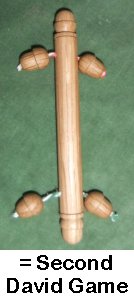
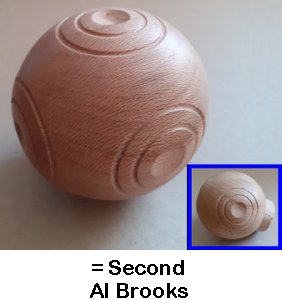
Vic's laminated cone of Yew, Ovangkol & Elm had a
Black Wood bar seemingly locked within it, but with a knowing thump in the right
place, it can be removed.
Not so obvious in this photo but David's red & blue candy striped strings
seemed to have an unnatural influence on each other. If any acorn was extended,
the acorn that could pull it back was attached to a different coloured string at
the opposite end of the stick.
Al's sphere had a hidden box within it but cunningly concealed by the
ornamental coves. It opened by pushing the correct dimple on the opposite side
to the box. This required very precise turning to maintain tight joints.
Andy Ogilvie's interlaced rings was fooling everyone trying to work out
how to separate one. The only solution is with a hacksaw!
Paul's nail puzzle (balance 6 of the nails without any touching anything
more than the central nail and each other) was turned Laburnum on an Elm Burr
base. The Laburnum nails were so dense, they sounded like metal when dropped
upon the table.
Nick's magic ball-in-a-beehive trick had been precisely turned but had
suffered slightly by the Box Wood moving since it had left his lathe.
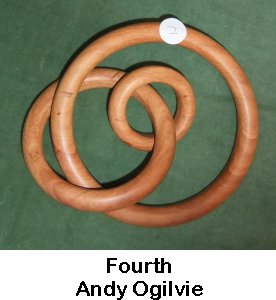
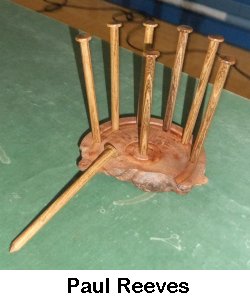

(click any above for close up view)
TABLE B
Regrettably, there were no entries forward for this table
September 2022 -
Appraisal Table
with Paul Reeves
(click any below
for close up view)
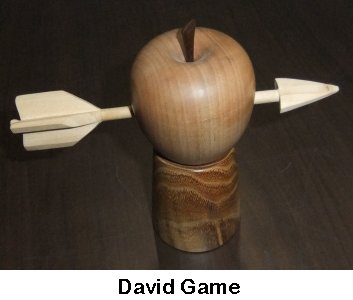
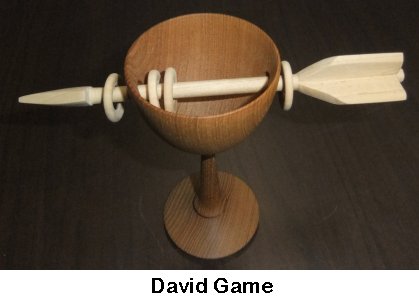
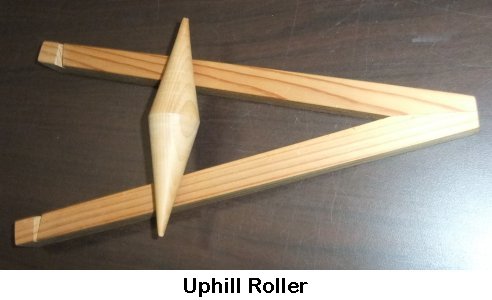
(click any above
for close up view)
In the spirit of this month's theme of Puzzles &
Tricks, David produced his 'embodied Lime arrows' ending up in impossible positions
leaving one to ponder how it's done.
The solution involves turning the
arrow separately then leaving the arrowhead in boiling water for 15 minutes
before squashing the blade back towards the shaft using a bench vice, protected
with polythene against rust & stains and ensuring that the edges were being
crushed and not just folded over. David left
the arrow & vice in this position for 3 days before pushing it through the
apple/goblet which had been drilled with a hole slightly larger than the arrow's
shaft. With the arrow now in its final position, he submersed the crushed head in
a cup of hot water which miraculously allowed the wood cells to expand and return the
arrowhead to its original shape.
David's Uphill Roller is an optical illusion. Although not so evident in the
photo, the wood is thinner where the arms are joined at the right of the photo
than the opposite ends at the left of the photo, yet the roller always
moves from the apparent lower end to the
higher end.
The reason is due to the cone shape of the
roller; when at the lower jointed end, the cone has larger diameters
resting on the track arms which makes the centre of gravity of the cone higher
than when it rests on the track arms at the separated ends where the cone
rests on smaller diameters. Although the track arms are increasing in height,
the slope is not enough to negate the effect of the reducing cone diameters. As gravity acts upon the C of G, the cone has to
move from the right side of the picture to the left.
Vic's captured mouse within a Sycamore wedge of cheese was another marvel
to ponder. Despite all attempts, one couldn't pull the mouse clear of the
cheese.
Joe's logic string puzzles relied upon planning several moves ahead.
Fortunately, he was around to reset it when your editor managed to get it in a
more complicated knot than he started with!
(click any below for close up view)
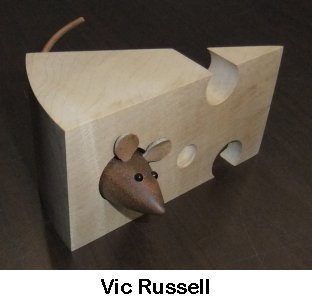



(click any above for close up view)
Paul's Oak sapwood platter had moved and cracked slightly
over time, but after applying some oil, the piece decided to resemble an
enormous Pringle and he wasn't too sure what to do with it.
His cruet set was designed so that each lid had identical seats so that
although the hollowed bodies were individual, any of the lids would fit them.
Paul's Ribbed Bowl showed testament even when glued to a former, there is
still a minimum thickness you can achieve before the problem of flexing
disintegrates the piece.

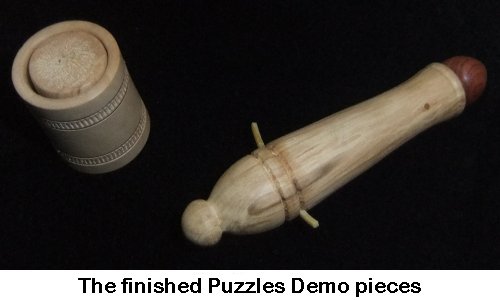
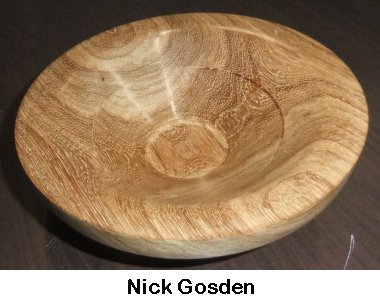

August 2022 -
Appraisal Table
with Paul Reeves
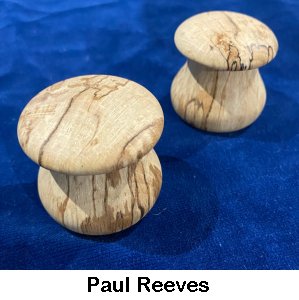
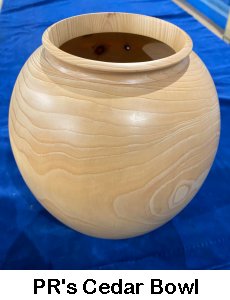
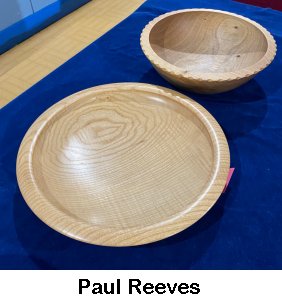
(click any bowl for close up view)
The recent Ellingham Show (returned
after a 3 year absence) was both hot and a great success for showing the prowess
of the Club. A firm favourite with children was turning tooth fairy boxes
out of spalted branch wood, particularly if they were fortunate enough to be
awarded the finished item. Paul could not be convinced that the boxes should be
enlarged to accommodate a two pound coin.
A common fault with hollow forms is variable thickness of walls,
particularly where the inside cross-section starts to reduce; mostly caused by
the turner pressing outwards and downwards rather than guiding the tool around
to match the outside edge. A good check of success (or not) is to look into the
opening while a bright light is shone close to the outside surface. Paul's
example was of Cedar, which is especially difficult to turn a thin wall and as
such, not best suited for hollow forms.
Paul's rippled Ash Bowl was to highlight that the bottom of your piece can
look as nice as the top. This bowl was buffed and waxed with Carnuba whereas the
White Walnut Bowl next to it was finished with mineral oil, which never sets so
has the drawback of eventually washing off and leaving a dull finish. This
doesn't happen with oils like Walnut or Lemon Oil which will set hard/cure after
several days and can maintain their sheen.
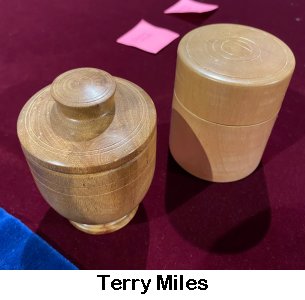
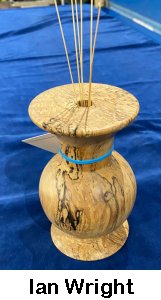
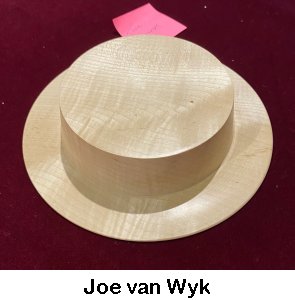
(click any above for close up view)
Terry's 2 boxes out of branch wood of a fruit
tree are ideal for matching grain & a good fitting lid, even 3 years after they
were turned.
Ian had turned a vase with a glass tube well hidden within.
Joe's very thin half-sized boater hat was remarkably unaffected by shrinkage or
wrinkling. Apparently long dried roughed out blanks that had received their
final turn on his lathe the day before.
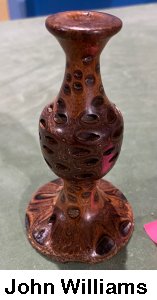
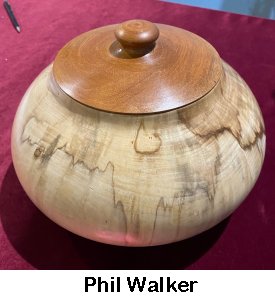
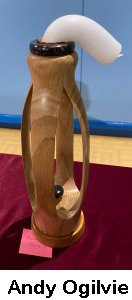
(click any above for close up view)
John's Banksia had been turned a few
years ago but he still remembers the hard sharp chips spinning off his gouge.
New Member, Phil had produced a Sycamore Bowl which he had finished by
hand-buffing with Carnuba wax. Paul admired the contrasting wooden lid but
warned that the fit was likely to change from day to day.
I had initially thought that Andy's candle holder was a clever piece of
artistry, but apparently, it was a natural casualty of the heat inside the
Ellingham Show's tent where the Club had put up its display table.
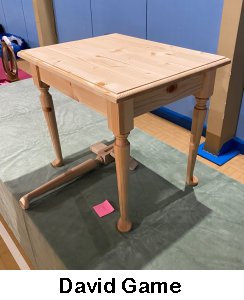
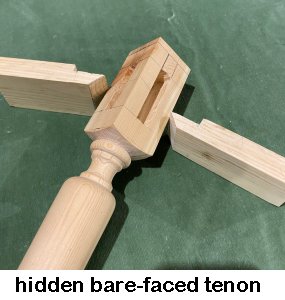
(click any above for close up view)
David's beautifully produced small table with elegant cabriole feet set on the diagonal is a testament to his Cabinet Maker's apprenticeship. He had helpfully brought an example of its construction using bare-faced tenons.
TABLE A
(click any below for close up view)
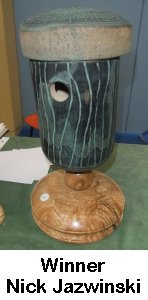
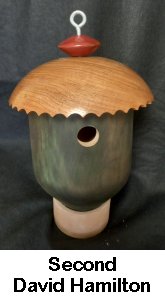
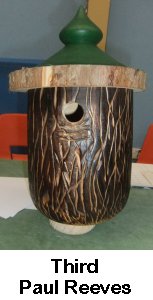
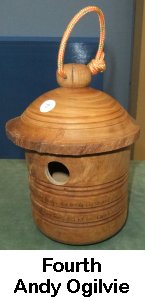
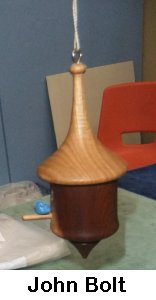
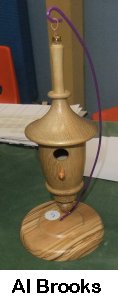
(click any above for close up view)
Nick's winning entry had used some verdigris wax on the lid and
body of his bird box which would suggest water-proofing qualities although
Liberon don't specifically list it for external wood. David's green effect
was achieved with stain.
Chairman Andy highlighted that virtually all of us spend a long time with our
competition entries but whenever Paul conducts a demonstration, he invariably
enters competitions with his demonstration piece produced within 90 minutes
including many discussion points. His only 'tweaks at home' this time were to paint the
lid and re-scorch the body.
Most spotted Andy's pyrographed verse but few noticed the twist opening of his
lid for easy access to clean.
John & Alan's entries were obviously not intended for practical use but their
detailing and finish were a delight to behold.
TABLE B
(click any below for close up view)
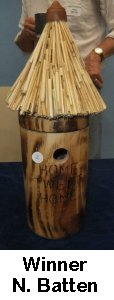

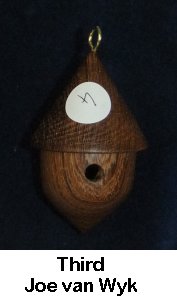
(click any above for close up view)
Nigel Batten's innovative thatch lid
and pyrographed pun was a deserved winner.
Geoff had chosen old-school design with a perch but his was carefully finished
off rather than just a plain dowel.
Joe's piece was purely ornamental and had produced a beautifully textured roof.
July 2022 -
Appraisal Table
with Paul Reeves
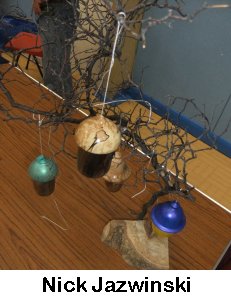
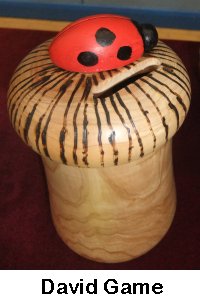
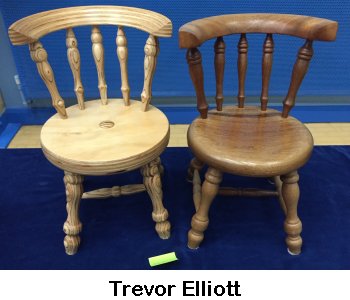
(click any above for close up view)
Nick's model of a tree with ornamental bird boxes
was a colourful bit of fun but must have been a nightmare to transport to Club
Night.
David's Ladybird Moneybox has a secret opening to get to the hoard; a wooden peg
attached to the bug's head clears a turned ring when pulled out to release the
ladybird's body and lid. Simple but very impressive.
We're guessing Trevor's grandchild has got a little taller. An attractive
effect on the spindles and chair back.
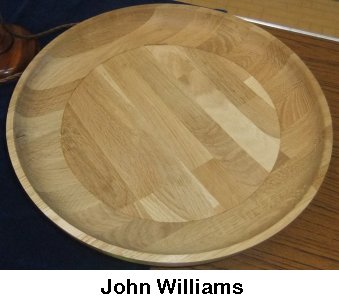
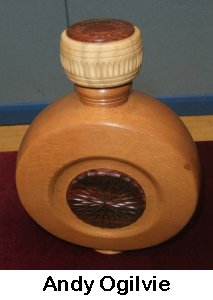
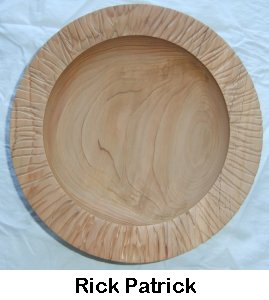
(click any above for close up view)
This photo is misleading because John's oak
platter is 23" in diameter; fellow member Geoff Hewitt had a lot of kitchen
laminate worktop over following an under-sized order by his kitchen designer.
Paul commented that glue in laminates are often so weak that they can readily fly
apart when turned. John had applied a second layer of worktop at right angles to
the first which helps to stabilise the turned piece although it is still
difficult to prevent pull-outs where the top & bottom layers meet. He also
commented that the underneath decoration made the upper side look quite plain.
Andy has been encouraging members to have a go at flasks and has lead by
example; Paul commented that its heaviness exposed that not much had been
hollowed but it bore some impressive ornamental lathe work. As a general tip, he
advised to be careful turning a spout to finish with a thin edge as the grain of
the wood is likely to rebel.
Rick made his first attempt at using a Proxxon carving tool on this Maple
bowl rim. In some respects, becoming competent & confident in using the tool can
easily lead to a uniform (and boring) marks whereas the irregular depths,
spacing & angles of a beginner tends to look random and more interesting.
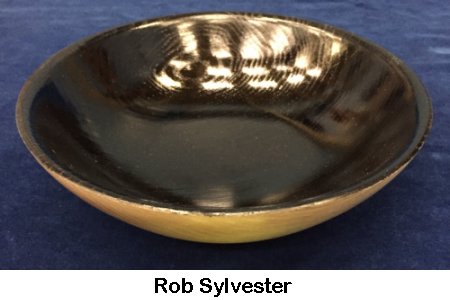
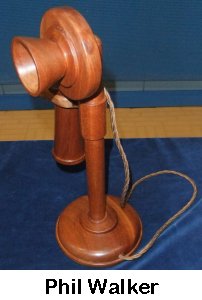
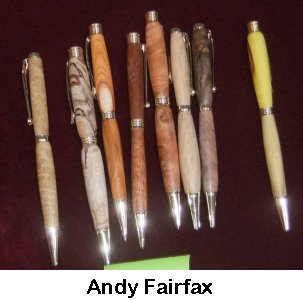
(click any above for close up view)
Rob's ash bowl appeared to have been sprayed
with a black lacquer whereas he had applied Liberon Black Polish (an ebonizing
French polish). He did add that it took "a lot of layers" to reach such a high
gloss.
Phil's candlestick telephone was well worth a close look with its sharp
lines and clean surfaces.
Andy's shiny new pens looks like he's got his Christmas gifts sorted.
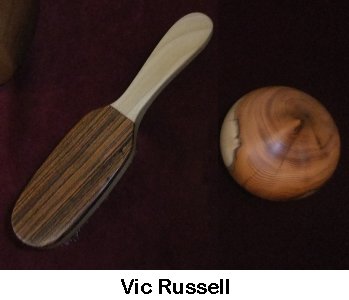
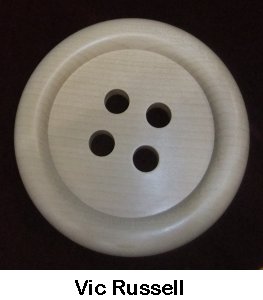
(click any above for close up view)
Vic's hairbrush bristles were fitted a traditional way - lengths of bristles were pulled in by some fishing line around their centres and tied off at the back of the brush head. His teardrop shaped paperweight had a wonderful tactile feel in one's hand. The button was about 8" diameter and Paul wondered whether some copper wiring through the holes might enhance the piece.
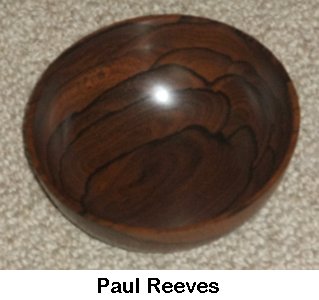
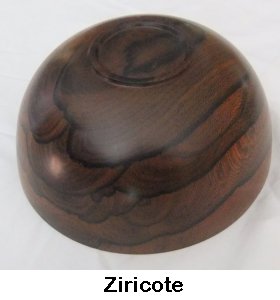
(click any above for close up view)
Paul had brought some of his more exotic woods. The first was Ziricote from Central America, which is becoming rarer and expensive. Its beautiful wavy grain (nothing to do with annual growth rings) has a luxurious appearance and tends to be used for the finest furniture or musical instruments. Paul warned that it is still available but do take care to see that the lumber has many black wavy marks - the cheap ones tend to have only a few.
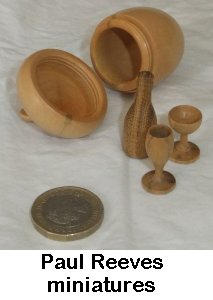
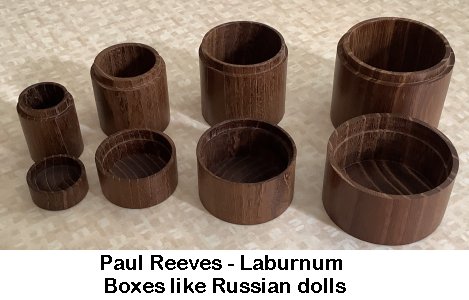
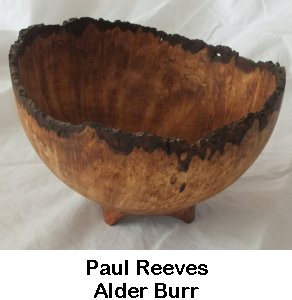
(click any above for close up view)
Following on from Mike Haselden's
end of demo party piece, Paul had brought in, by coincidence, some of his own
miniatures.
His Laburnum boxes were obviously dry when he turned them as they still fall
inside one another with a soft close action.
Alder Burr is another unusual wood to find but is worth getting as the wood
looks pretty and is so stable after turning.
June 2022 -
Appraisal Table
with Paul Reeves
(click any below for close up view)
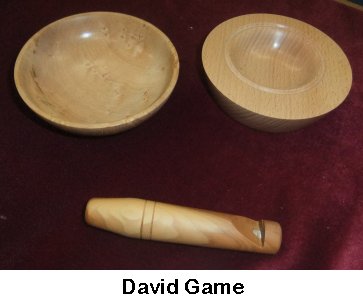
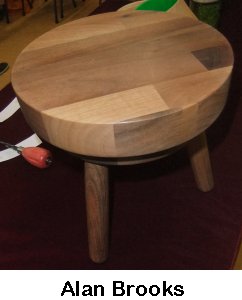
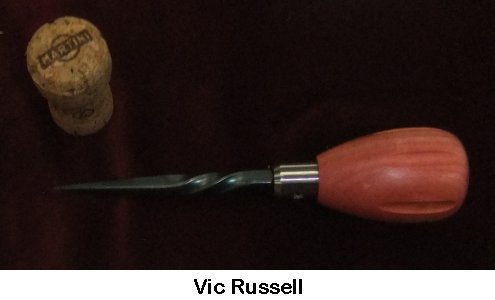
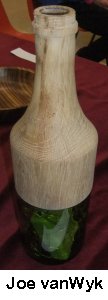
(click any above for close up view)
David Game had brought a whistle (which can often
take a lot of time fiddling in order to produce a decent sound but on this
occasion worked well straight off the lathe), a Maple saucer, and an offset
bowl turned using a faceplate.
Alan Brooks had made use of a 'lazy-susan' to produce a 3-legged stool with a
rotating seat scrounged from a superior worktop.
I had originally labelled Vic Russell's piece as an ice-pick but stood corrected
that it was a Birdcage Awl with a beautifully turned Pink Ivory handle and a
hand twist of the awl itself done by Vic. I'd like to think that I was
swayed in my identification by the sparkling wine cork, but I suspect it was
more influenced by my imaginary life style or love of crime fiction.
Joe van Wyk has been cutting bottles again and this example was a crystal clear
example with the added surprise of lights. It seems Joe has nearly as many
rejected attempts of glass cutting as he has successes.
(click any below for close up view)
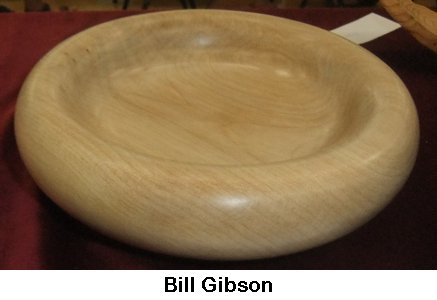
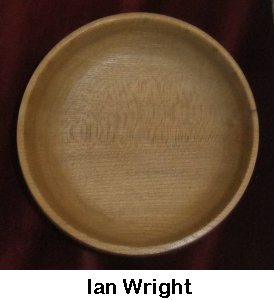
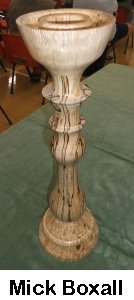
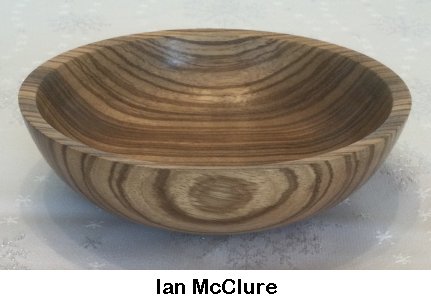
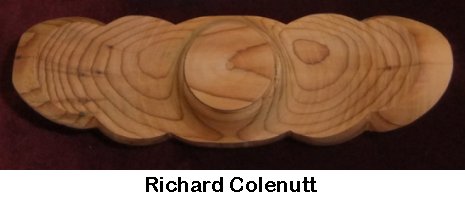
(click any above for close up view)
Three more bowls were up for appraisal - Bill Gibson had
turned an edgeless Sycamore; Ian McClure with Zebrano and Ian Wright with Elm.
Richard Colenutt had brought one of his try-outs for the Unnatural Natural Edged
competition and Mick Boxall had brought an elaborate Silver Birch candlestick.
Clearly Mick had spent a lot of time and work on this piece but it was
interesting to hear how it would be assessed in a competition. From bottom to
top, he had turned a torus within the base, 2 different sized bead mouldings and
two capitals leading to the candle cup. Individually, they were pleasing shapes
but lacked matching design profiles and symmetry within the one column. Something to consider
for the piece to be marked better might be if, for example, the candle cup had a
matching torus, the beads were of matching shapes and relative heights and
similarly for the capitals or even follow the maxim, "less is sometimes more".
(click any below for close up view)
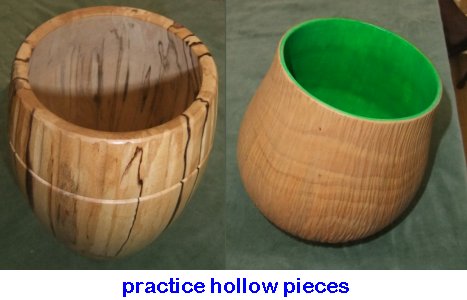
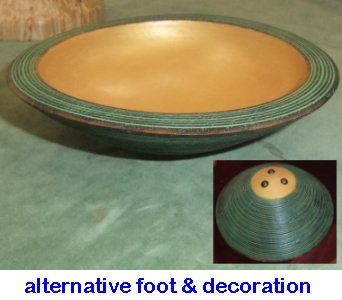
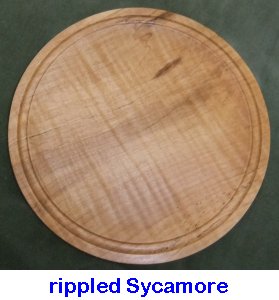
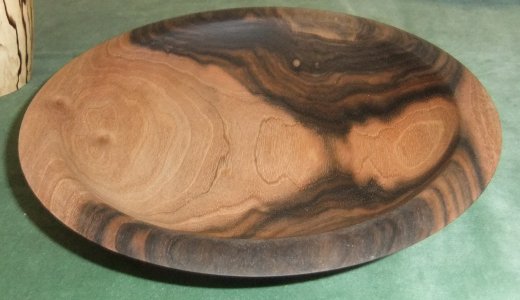
(click any above for close up view)
Paul had brought some of his own work to suggest
ideas we might not have thought of.
The latest competition required some hollowing and if this technique is new to
you, he recommended to practice with a wide opening to start with as you can
then see clearly which angle to present in order to get the best cut.
A foot doesn't have to be formed from the body of the turned piece - the above
is accomplished with 3 hobnails. The decoration was created from an old chisel
with 3 beads ground into the end.
Decoration can sometimes be found within the wood. Paul had brought a fine
example of 'rippled' in the side grain of Sycamore caused by compression of the
grain by the weight of the tree or a heavy branch moving in the wind as it grew.
May 2022 -
Comp 1
Unnatural Natural Edge
TABLE A
(click any below for close up view)
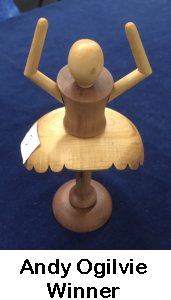

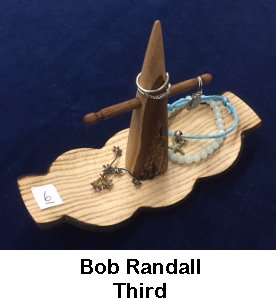
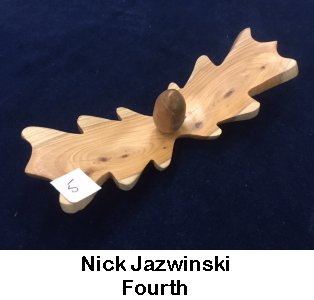
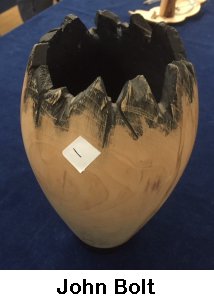

(click any above for close up view)
TABLE B
Regrettably, there were no entries forward for this table
Click <HERE> for Club Years 2021 & 2022
Click <HERE> for Club Years 2019 & 2020